The debut of the Haier brand in the European television market with the K85F model feels hurried, and after thorough testing, it seems almost unfinished. Analyzing this product leads us to a fundamental conclusion: its biggest problem is not the quality of the panel used. This, considering the price segment, is simply average, with the typical advantages of VA technology in the form of high contrast and equally typical disadvantages, such as poor viewing angles. What truly disqualifies this model as a home entertainment centre is the glaring lack of engineering refinement and, above all, software development. The list of shortcomings is long and starts from the very first contact with the device. Sloppy assembly, which could have been avoided during quality control, a poorly optimised and badly translated Google TV system, or annoying issues with basic functions like pairing the remote – all contribute to the picture of a product that seems to have been released to market without due diligence. The catastrophic image quality in HDR mode, resulting not only from low brightness but also from a complete lack of intelligent adaptation to the signal, only adds to this disappointing picture. However, it turns out that this model has a surprising second face. One needs to look at it not through the lens of a home television, but rather as a large and inexpensive display for special tasks. Then its shortcomings become less important, and unexpected advantages come to the fore: a fantastically working media player with USB, remarkable font readability from a PC, and access to a vast application database. In this role – as a screen in a conference room, hotel lobby, or simple advertising player – the Haier K85F performs surprisingly well. For the typical user looking for a reliable and simply well-functioning television for the living room in 2025, however, the Haier K85F is a proposal that is incredibly difficult to recommend with a clear conscience. It is a product full of contradictions, which fails in its primary, intended function on too many fronts.
- Matching (Score)
- Our verdict
- TV appearance
- Where to buy
- Contrast and black detail
- HDR effect quality
- Factory color reproduction
- Color reproduction after calibration
- Smoothness of tonal transitions
- Image scaling and smoothness of tonal transitions
- Blur and motion smoothness
- Console compatibility and gaming features
- Input lag
- Compatibility with PC
- Viewing angles
- TV efficiency during daytime
- Details about the matrix
- TV features
- Apps
- Playing files from USB
- Sound
Haier K85F vs Haier Q80FUX
Direct compare
K85F / K85FUX


Panel type: LCD VA
Resolution: 3840x2160
System: Google TV
Model year: 2025
Complete the survey to find out the result

Panel type: LCD VA
Resolution: 3840x2160
System: Google TV
Model year: 2025
Complete the survey to find out the result

Overall rating
5.4
5.8
Movies and series in UHD quality
5.2
5.9
Classic TV, YouTube
5.2
5.6
Sports broadcasts (TV and apps)
4.6
4.7
Gaming on console
6.4
6.7
TV as a computer monitor
6.0
6.0
Watching in bright light
4.1
4.8
Utility functions
5.5
5.6
Apps
9.6
9.6
Sound quality
4.8
5.5
Complete the survey to find out what fits your preferences
Advantages
Low input lag, excellent for gaming
Surprisingly good media player via USB
High contrast and decent black levels (VA panel)
Good text readability in PC monitor mode
Presence of gaming features: ALLM and VRR
Access to numerous applications thanks to GoogleTV
Very good native contrast and decent black (thanks to the VA panel)
PFS / QLED filter - Wide colour gamut (approx. 95% DCI-P3)
Remarkably low input lag (below 10 ms at 120Hz and around 12 ms at 60Hz), making it an excellent choice for fast-paced games.
Support for 120Hz in lower resolution (Full HD) and the presence of VRR and ALLM
Support for Dolby Vision
Well-functioning file player from USB
Presence of an analogue headphone output (jack)
Disadvantages
Catastrophic image quality in HDR mode
Low quality of workmanship and fitting of materials
Slow, stuttering and poorly translated Google TV system
Very poor sound quality from the built-in speakers
Problematic remote control (and no batteries included)
Poor viewing angles
Low brightness and weak anti-reflective coating
Low colour gamut coverage
The image is quite heavily "blown out" in HDR
Google TV software is full of bugs, poor translations, and issues
Lack of any image enhancement features (noise reduction, gradient smoothing)
Average brightness
Flat, bass-less sound
High input lag in Dolby Vision mode for gaming
Odd and poorly ergonomic remote
Our verdict
The Haier Q80FUX television is one of the most schizophrenic propositions we've had in our editorial office for a long time. On one hand, we have a solid piece of equipment here: a VA panel ensuring deep blacks, as expected in this segment, and a QLED quantum filter that can indeed produce vibrant, eye-catching colours. This is the foundation upon which a really competitive mid-range receiver could have been built. Unfortunately, all this matrix potential is systematically thwarted by the software, which represents a true millstone around the neck of this model. The Achilles' heel of the Q80FUX is its total capitulation when faced with HDR10 materials. The electronics seem to completely misunderstand how to interpret the signal, resulting in the brightest parts of the image being continuously blown out, turning them into a flat, milky patch. If we add the Google TV system to this, which, although functional, is unstable, full of bugs, and annoying shortcomings, we see a product that feels raw and clearly shows the manufacturer's lack of experience. Just when we thought we had written this model off, we discovered its surprising niche. Once connected to a console, the Q80FUX undergoes a transformation. It turns out that this television offers an impressively low input lag, fully supports VRR, and can handle a 120Hz signal in Full HD resolution. In the gaming world, where responsiveness is everything, these parameters put it in a very good light. So, we are dealing with a device of very narrow specialization. This is not a universal living room television – it lacks stability and above all, any correctness when handling films. Rather, it is a budget-friendly, large-format monitor for gamers, who can consciously forgive it all the software flaws in exchange for those few key attributes needed for consoles/PC at a relatively affordable price.
TV appearance


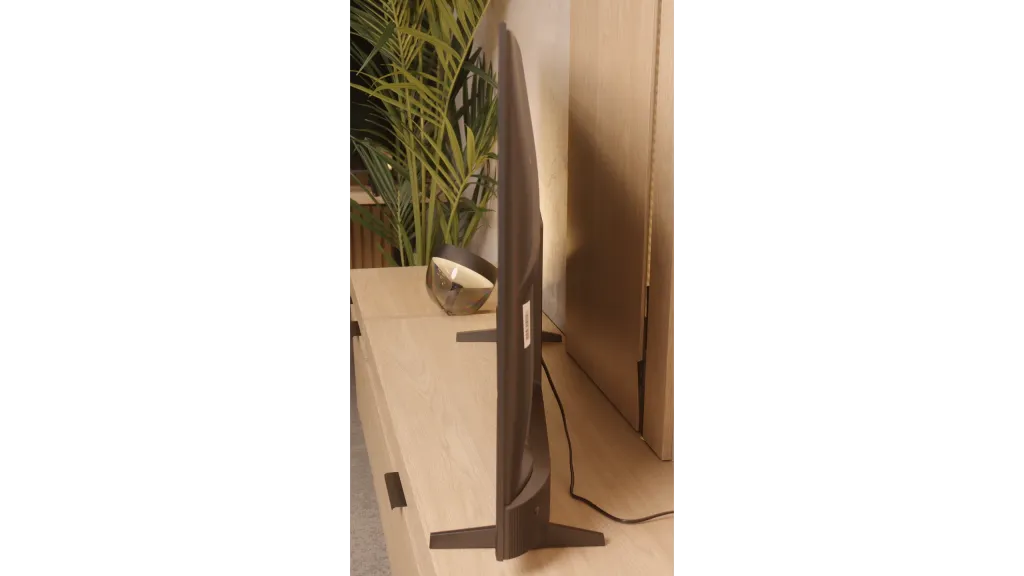



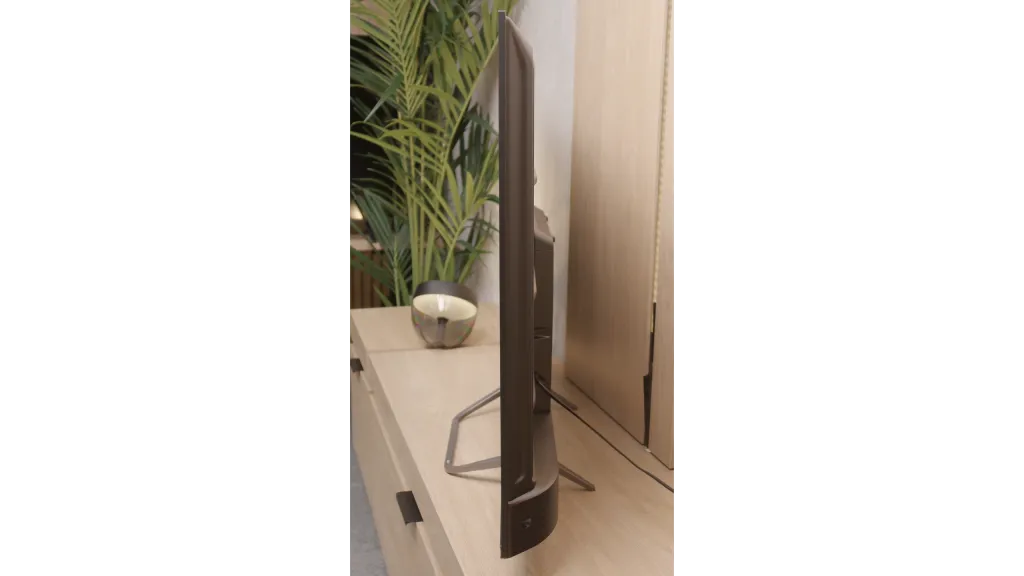
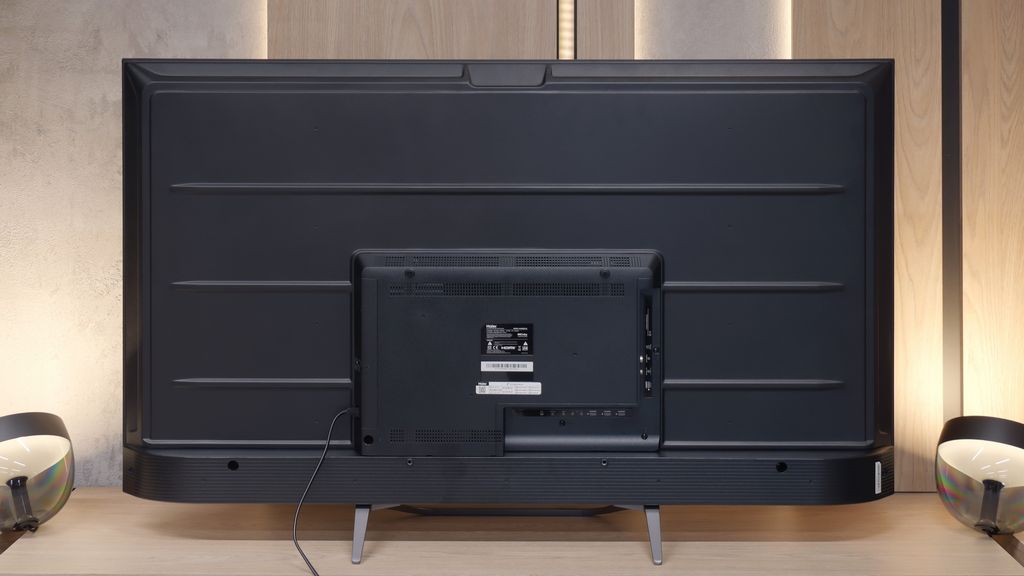
Contrast and black detail
5.6/10
6.3/10
Local dimming function: No
Local dimming function: No
Contrast:

Result
3,550:1

Result
5,200:1

Result
5,350:1

Result
5,400:1

Result
3,500:1

Result
5,200:1

Result
7,400:1

Result
7,550:1

Result
7,300:1

Result
6,450:1
Halo effect and black detail visibility:

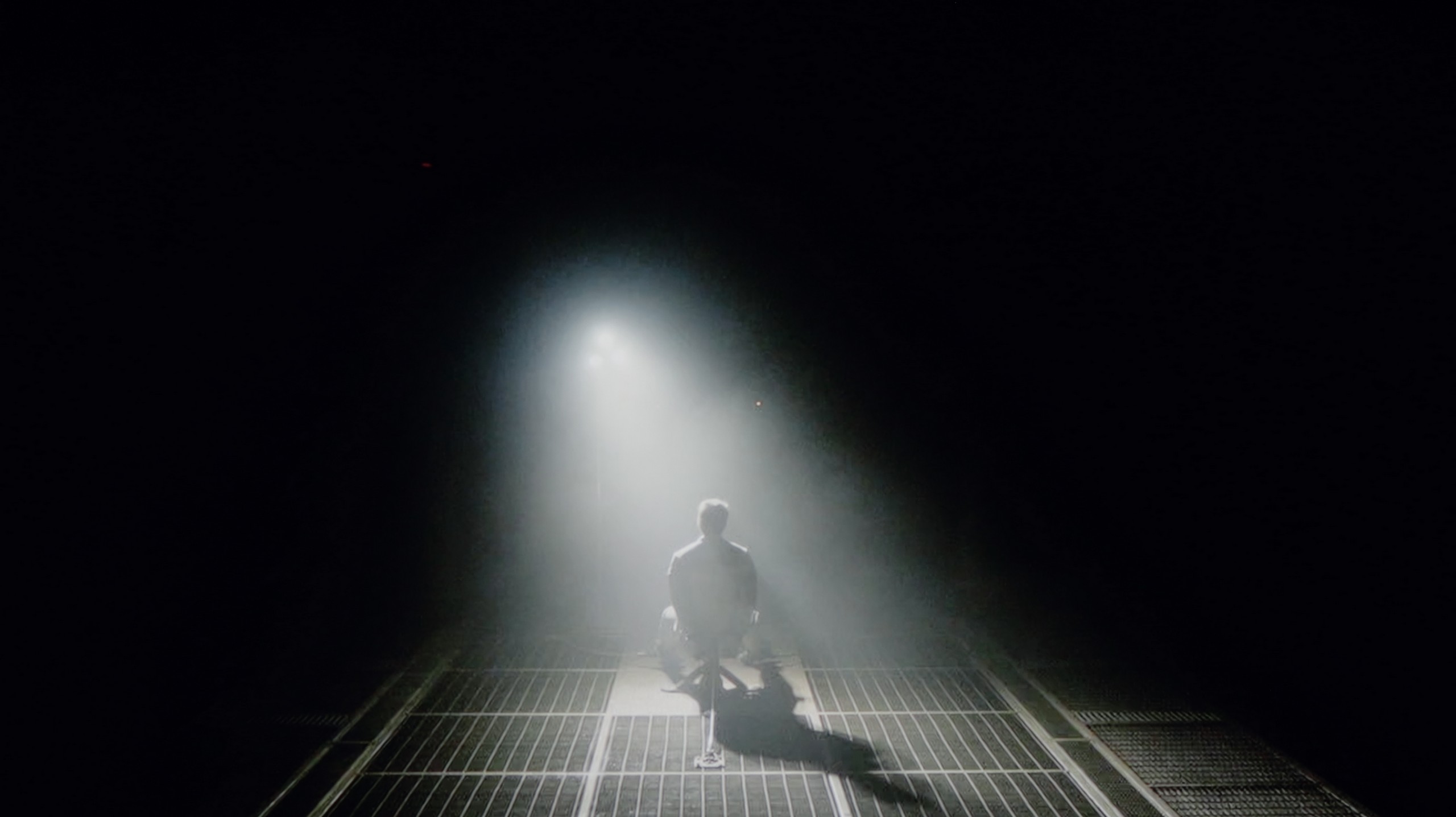
Well then, let’s get to the point, which is how the Haier K85F handles black levels and contrast. The key information is that the television uses a VA panel, which has a significant impact on the image quality in dark scenes. It is precisely because of this that the contrast is really solid – our measurements showed values around 5000:1, which is much better than that of popular IPS panels.
However, one must remember that we are talking about equipment from the lower price range. Therefore, one cannot expect any advanced technologies, such as local dimming. The backlighting works across the entire surface of the screen all the time. How did this look during viewing? We took the film “Oblivion” with its cosmic landscapes for a test, and also checked classic black bars in other productions. The effect was quite decent. The black had good depth, but it was not perfectly pitch black – a subtle, navy blue glow could be seen, indicating that the panel's backlighting was still active.
I must admit that approaching a receiver in this price range, one instinctively crosses their fingers, hoping that at least the black won’t be a grey patch. Meanwhile, the Haier Q80FUX, specifically the 55-inch specimen residing in our editorial office, can very positively surprise in this regard. Its secret lies in the use of a VA panel, which inherently has a tendency to generate high contrast. And these are not empty promises. During screenings, in most cinematic shots, the contrast consistently reported levels from 5000:1, often reaching the threshold of 8000:1. These are really strong results, considering the fact that this television does not possess any, even minimal, form of local dimming. Translating this into experiences from behind the couch: for its price point, the Q80FUX offers simply solid black. Of course, it is not that perfectly velvety depth that makes the screen disappear into darkness. When we conduct a screening in conditions of full isolation from light, we notice that in the darkest parts of the image, the black reveals its budget origins, subtly veering towards a bluish hue. However, this is a defect that is easy to mask – just a bit of light from a lamp in the corner of the room is enough for this nuance to become invisible, and the image to regain satisfying depth.
HDR effect quality
3.4/10
4.9/10
Luminance measurements in HDR:

Result
217 nit

Result
212 nit

Result
278 nit

Result
250 nit

Result
273 nit

Result
308 nit

Result
327 nit

Result
352 nit

Result
330 nit

Result
344 nit
Scene from the movie “Pan” (about 2800 nits)


Scene from the movie “Billy Lynn” (about 1100 nits)


Static HDR10


HDR luminance chart:
Haier Q80FUX
HDR luminance
Haier K85F
HDR luminance
Let’s now turn to one of the hottest topics in the world of televisions, namely the quality of HDR effect. In the case of the Haier K85F model, we must unfortunately make it clear: if you are looking for equipment to watch content in a wide dynamic range, you should avoid this model at all costs. The main problem is its very low peak brightness, which during our tests barely reached 250 nits. To give you a better idea of what that means – such a value is fine for watching standard SDR content, but it is absolutely insufficient to showcase any real benefits of HDR. The image simply lacks the "power" to generate bright, striking highlights. All our measurements and tests on specialist patterns only confirmed this. As if that weren't enough, the television also struggles with colour reproduction. In this budget build, we won't find any technologies to expand the colour palette, such as quantum dot layers (marketed as "QLED"). As a result, the coverage of the DCI-P3 colour space, which is crucial for HDR materials, is only around 80%. In practice, this means that the image will not only be dark but also devoid of the vibrant, saturated colours that the director wanted to show us.
Alright, let’s move on to the topic that stirs up so much discussion, namely the capabilities of the television in HDR mode. Let’s state it clearly right away: the Haier Q80FUX is certainly not a brightness demon. The panel of this receiver can generate about 350 nits at peak, which in today’s terms is the absolute minimum to even talk about the presence of High Dynamic Range (HDR). On the positive side, this power is at least stable – regardless of which test pattern or film scene we used, the measurements consistently oscillated in the range of 300-350 nits. These are therefore results that are at best sufficient, definitely far from the dazzling display of capabilities we are accustomed to with more expensive models. Fortunately, there is one aspect in which the Q80FUX compensates for these shortcomings and does so impressively. After all, we are talking about a QLED television (more precisely PFS LED), which means that thanks to the quantum dot filter applied to the panel, it can generate really juicy, vibrant colours. These are not empty promises – a DCI-P3 colour gamut coverage of nearly 95% is an impressive result and directly translates into colours that are very pleasant to the eye and saturated.
Factory color reproduction
3.8/10
4/10


Factory Mode
After calibration
Well, how does the television perform with colours straight out of the box, without any interference from our side? The Haier K85F offers a full range of picture modes, such as Dynamic and Eco, but for anyone who wants to watch films according to the creators' intentions, only one really matters: Film mode. That is where we focused our tests, and unfortunately, its name has little to do with reality. The picture in the factory settings is very far from what we could call cinematic fidelity and requires numerous adjustments. Let's start with the white balance, which has a noticeable deficiency of red. In practice, this means that the entire image has a cool, bluish tint. The situation is even worse regarding brightness management, namely the gamma curve (for SDR) and EOTF (for HDR). Their graph resembles a real rollercoaster, which has a disastrous impact on the viewing experience. This results in unnatural dimming of SDR content, causing details in shadows to be lost, and in the case of HDR – excessive brightness, which further exacerbates the issue of clipping. Such a combination, namely too cool white combined with chaotic brightness and excessive blue saturation, results in significant errors in colour reproduction. Our measurements on the specialist ColorChecker chart revealed errors (Delta E) regularly reaching and exceeding values of 8-9. Put simply, errors above the threshold of 3 are already easily noticeable to the naked eye, so such a result means that the colours on the screen are simply heavily distorted.
Factory settings for movie mode are rarely perfect, but in the case of the Q80FUX, we were confronted with a noticeable imbalance. In SDR content, the image was decidedly too warm, a result of excessive red in the white balance, giving the whole a slightly sepia tone. Ironically, in HDR materials, the television fell into the opposite extreme – an excess of blue caused an unnatural, cold effect in perception. However, it was not the capricious white balance that was the biggest problem with this television. The real culprit, responsible for the aforementioned issues, was hiding deeper. It turned out that the Q80FUX has completely miscalibrated gamma values and, crucial for HDR, a poorly executed EOTF curve. It was these erroneous factory settings that caused persistent clipping of the brightest parts of the image, overlaying them with that characteristic milky filter. Thus, we found the source of the problem. This state of affairs led to general, significant colour errors, which were easy to catch even for an untrained eye. Like every television we tested, we decided to calibrate this model as well, and the results of these adjustments can be found in the next paragraph.
Color reproduction after calibration
6.2/10
6.1/10




Well, is there anything that can be done about this picture? Can professional calibration save the situation? The answer is both yes and no. It must be clearly stated that there are certain limitations we cannot overcome. The constraints of the design itself, meaning simply a poor panel and its narrow colour coverage, make it impossible to expect a reasonable HDR effect – we won't mislead you on that. The biggest beneficiary of our adjustments is undoubtedly the SDR mode, and it is indeed for watching such content, after calibration, that this television starts to make sense. We managed to somewhat tame the white balance. Although the television only offers basic 2-point adjustment (rather than precise 20-point), so it's not perfect, we successfully eliminated that unpleasant, cold "chill" in the picture. Above all, however, we noted a significant improvement in brightness management. The gamma curve, which previously resembled a rollercoaster, looks like an almost perfectly straight line after calibration. This is a sign that the television can finally display images without artificially dimming or brightening them. The conclusion is simple: even with such a cheap television, professional adjustment of the settings can achieve a lot and extract the maximum potential from it.
The results of our calibration procedures must, regrettably, be acknowledged as twofold. Generally speaking, the picture is undeniably better than before the corrections; however, the biggest winner of this process turned out to be SDR content. It is precisely there, after correcting the gamma and white balance graphs, that we achieved results that can confidently be called very good. After adjustment, the Q80FUX truly shines in standard dynamics, showing only slight errors in the most difficult skin tone reproductions. Unfortunately, the weakest link remains HDR content. Here lies the paradox: despite having calibrated the white balance to nearly perfection, the overall colour errors still remain at quite a high level. The reason is that the television continues to interpret static HDR10 metadata "in its own way," stubbornly enforcing that unfortunate image burn-out effect, which inevitably leads to significant distortions. Although we have successfully eliminated the factory excess of blue, it is precisely due to this interference of electronics that the screen still tends to stray into somewhat overly cold tones. That is just how this television is.
Smoothness of tonal transitions
7.6/10
7.5/10
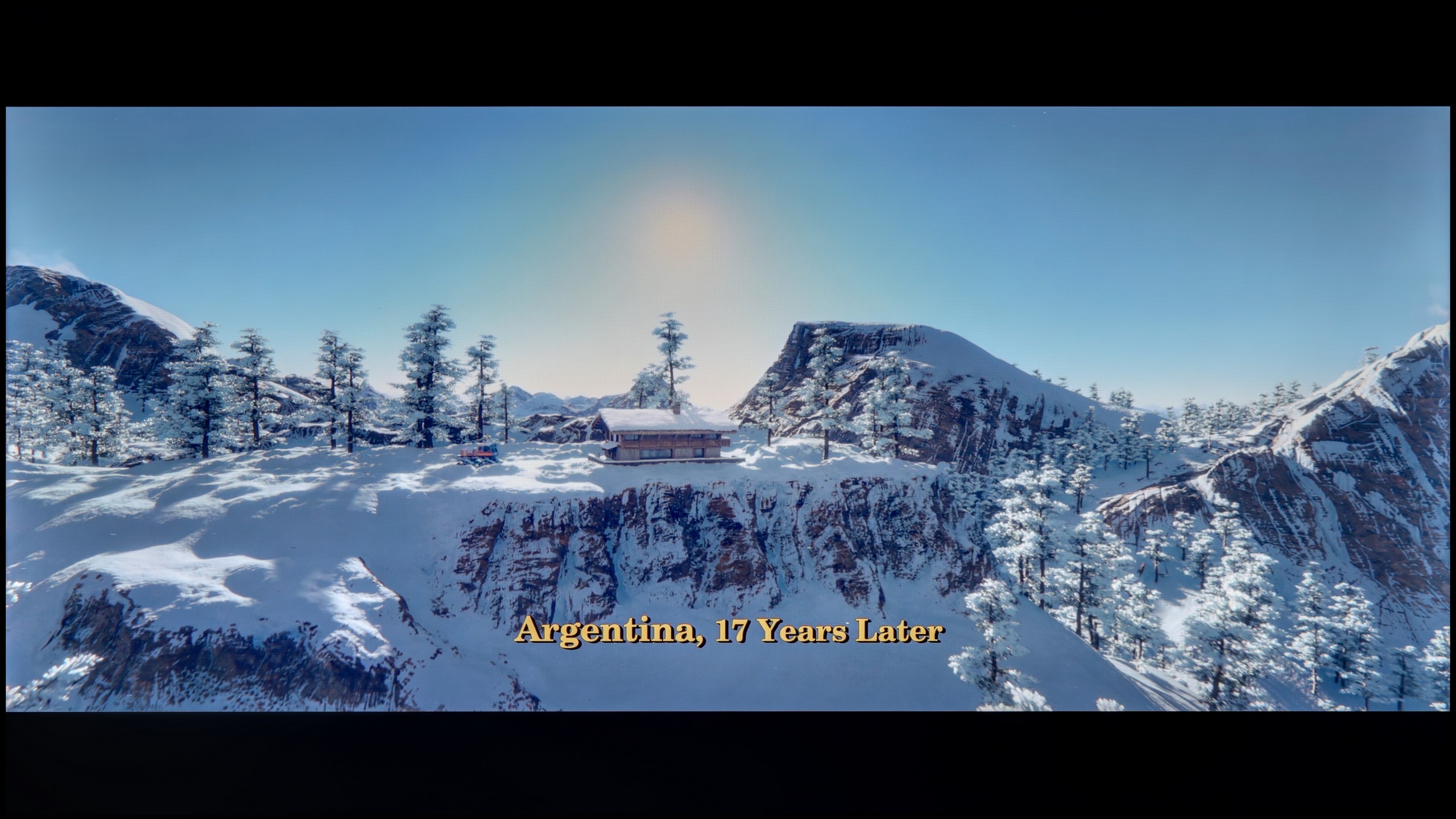
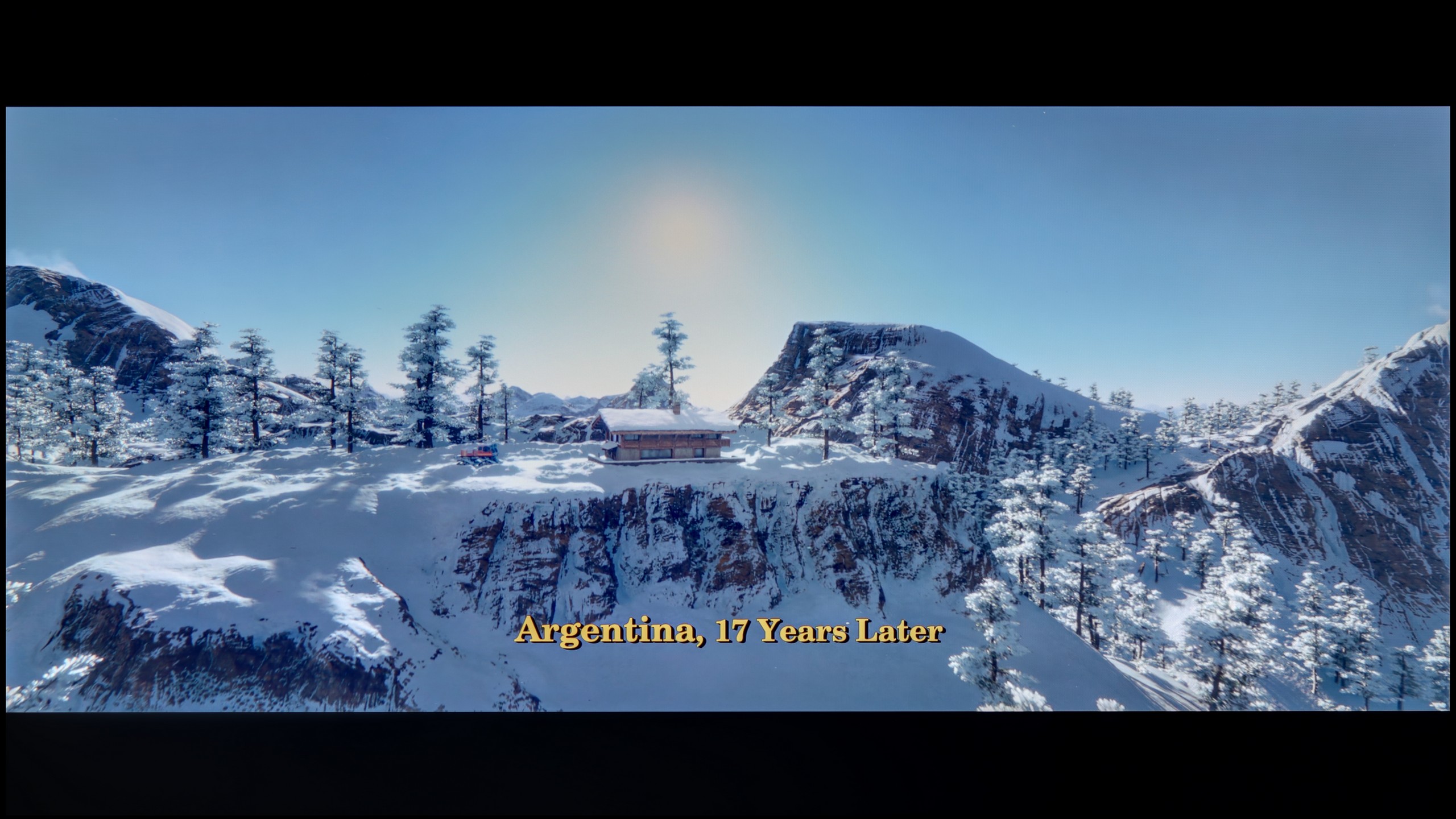










It’s time to address a matter that goes unnoticed by many, but can be very irritating to the discerning (and not just) eye. We are talking about the fluidity of tonal transitions, or how smoothly the screen displays transitions between very similar shades of a single colour – for example, on a clear blue sky. We must admit that in this category, the Haier K85F performs quite decently considering its price. In bright scenes, such as the aforementioned sky or vast landscapes in the film "The Martian", there are no strong, distinct bands. Indeed, if you look closely, you will notice minimal imperfections, but generally, the effect is more than satisfactory. However, the situation changes when darker scenes appear on the screen, such as murky corridors in games or night landscapes. Here, banding, or the posterisation effect, becomes much more visible. Transitions in shadows and greys are no longer as smooth and can irritate the more sensitive eye. It’s not a level that would completely disqualify the television, but it’s clear that this is an area where costs have been cut.
Analysing the ability of the television to handle subtle tonal transitions, known as "banding", leads us to interesting conclusions. The Haier Q80FUX seamlessly blends neighbouring colours in most scenes, creating a smooth, cohesive image. However, this process is not perfect. During testing, we noted minor issues and imperfections in every test scene we used. These may not be errors that aggressively stand out and ruin the viewing experience, yet their presence is worth noting. Interestingly, this receiver shows no particular weaknesses or strengths in this regard – it handles this challenge in exactly the same way, whether displaying delicate gradients of a bright sky or dark transitions in the shadows.
Image scaling and smoothness of tonal transitions
4/10
4/10
Smooth transition function

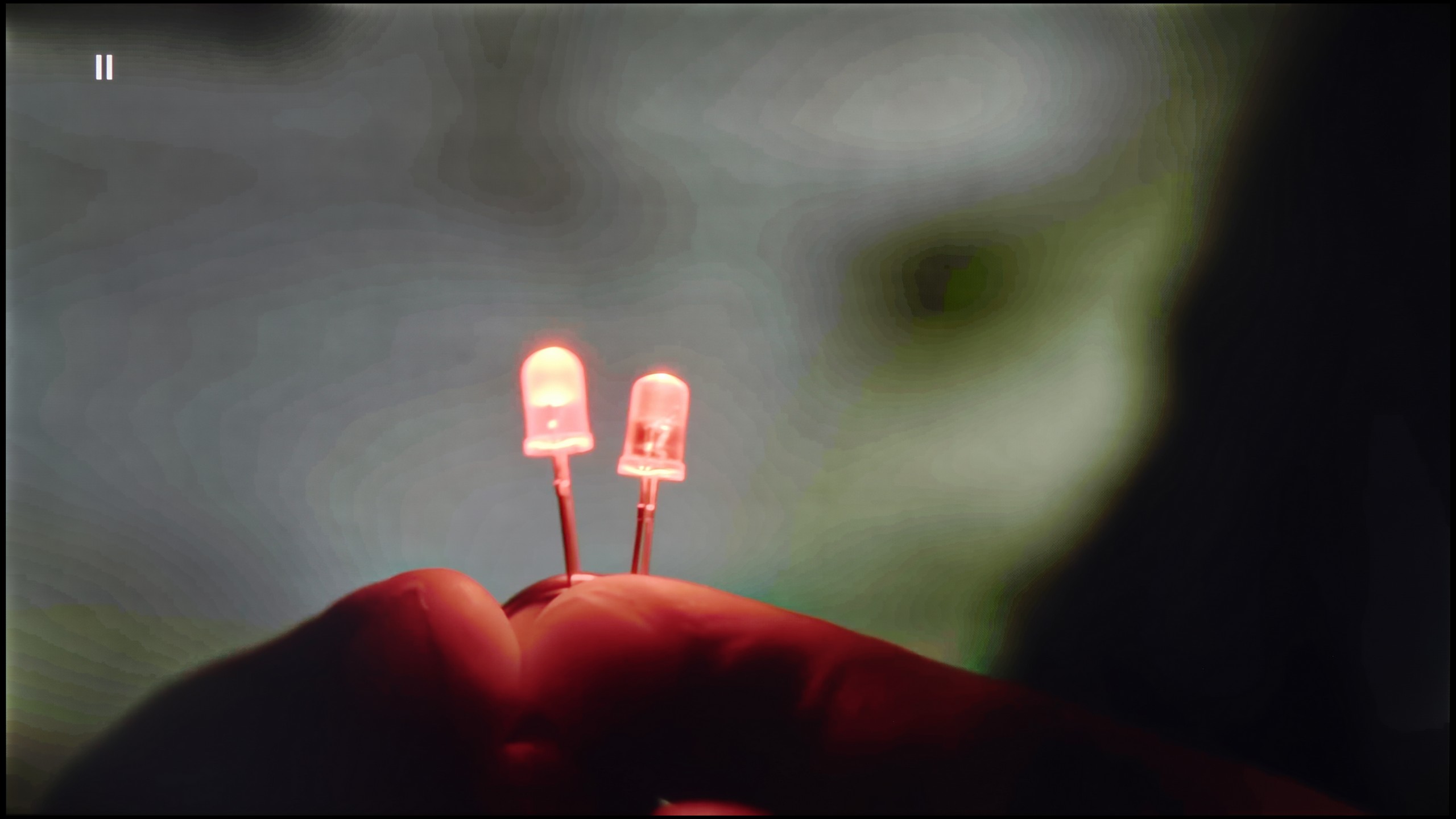
Image without overscan on the SD signal


Let's move on to digital processing and image scaling, specifically how the Haier K85F handles lower resolution signals, such as those from standard television. Right from the start, we encounter an extremely annoying and completely incomprehensible issue – overscan that is enabled by default. This means that the television artificially enlarges the image, cropping its edges, and this happens on every source, even 1080p. To see the full frame, you have to dig through the screen settings each time and manually switch the format to "expand to 16:9". It's a detail, but it's devilishly frustrating. The very act of scaling content to 4K resolution can be summed up in one word: acceptable. And that's about it. The image processor does not strip details from the picture, nor does it generate jagged edges or other artifacts. It simply does its job, without any fireworks. It's alright, but nothing more. However, the biggest and most noticeable shortcoming in the digital processing section is the absence of a smooth tonal transition feature. This is an algorithm that could significantly reduce the annoying banding effect we mentioned earlier. Unfortunately, the manufacturer did not provide such a solution, condemning us to watch the imperfections of the panel and low-quality materials in full view.
If there is one area where Haier clearly shows it still has a long way to go compared to the market leaders, it is digital image processing. The upscaling, well... is just alright. And that’s really about all that can be said about it. It does what is expected of it: it ensures that lower resolution signals do not scare us with harsh pixelation on the screen and do not look like a forcibly enlarged postage stamp. However, it is far from the finesse and “intelligent” sharpening that more experienced players in this market have developed over the years. The biggest shortcoming of the Q80FUX software is the almost complete lack of any additional "cleaning" and smoothing functions for the image. The receiver does not offer any noise reduction or gradient improvement mechanisms. This means that with older or heavily compressed materials, we simply have to come to terms with the fact that any imperfections in tonal transitions or blending of colours, which we mentioned earlier, will continually accompany us during the viewing.
Blur and motion smoothness
4.5/10
4.5/10
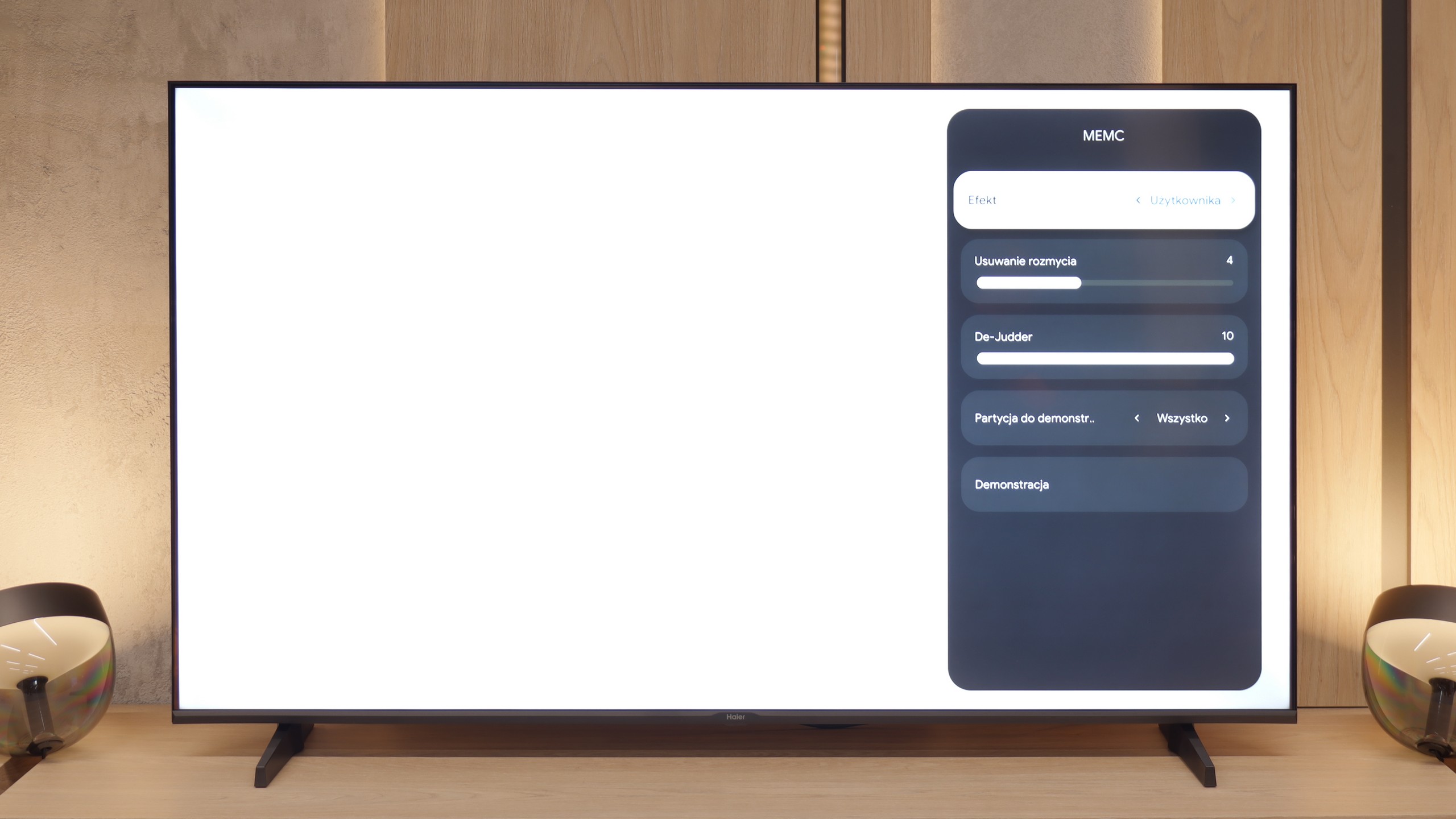
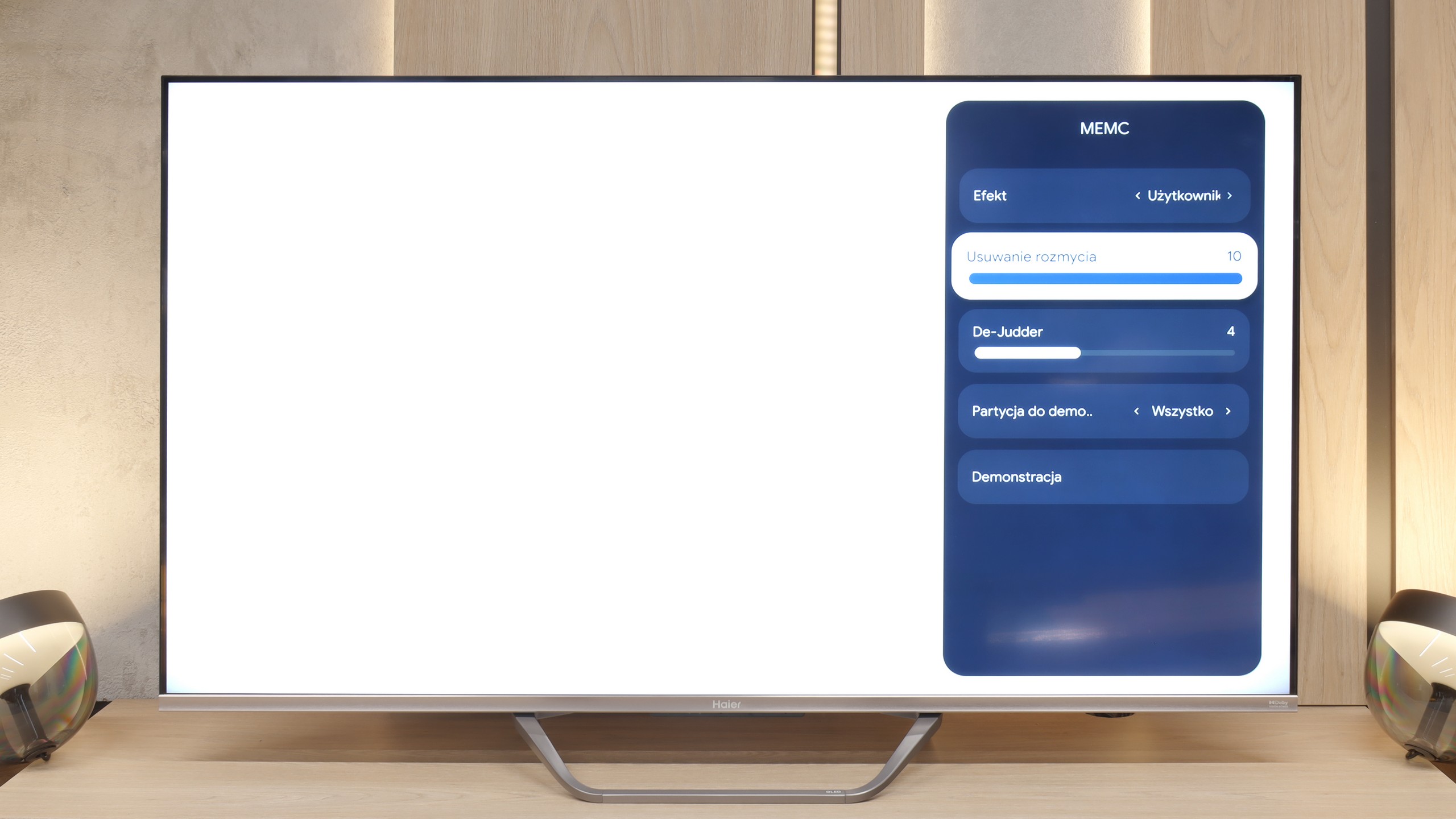
Blur (native resolution, maximum refresh rate):
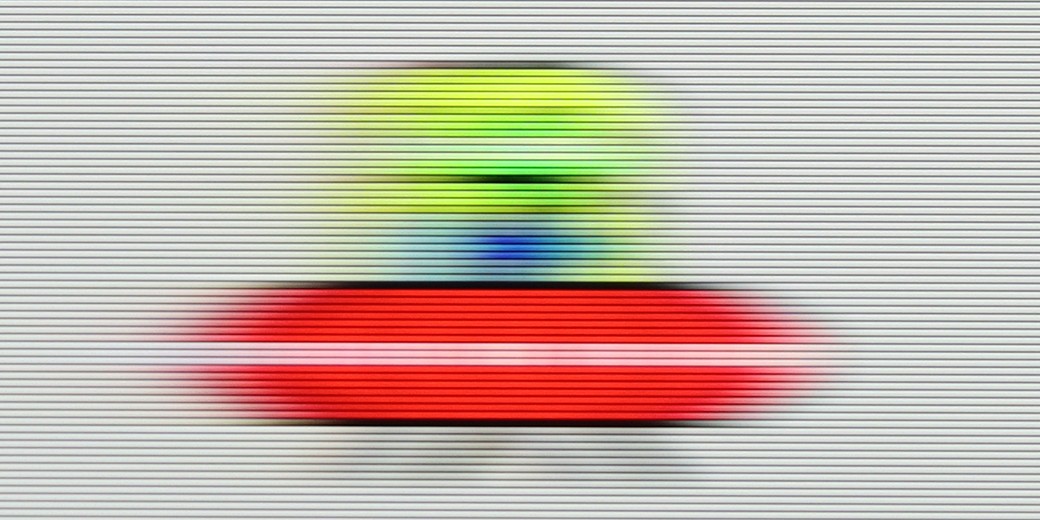
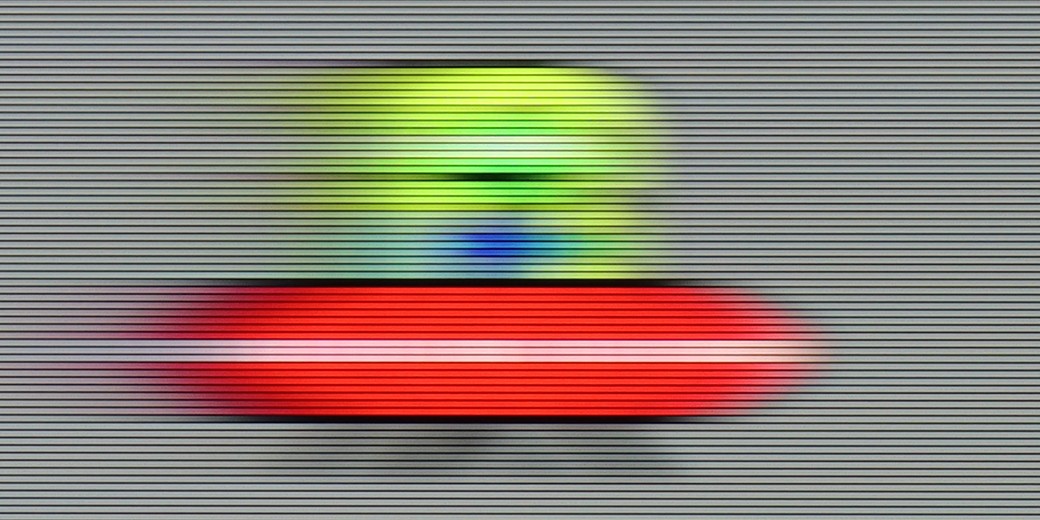
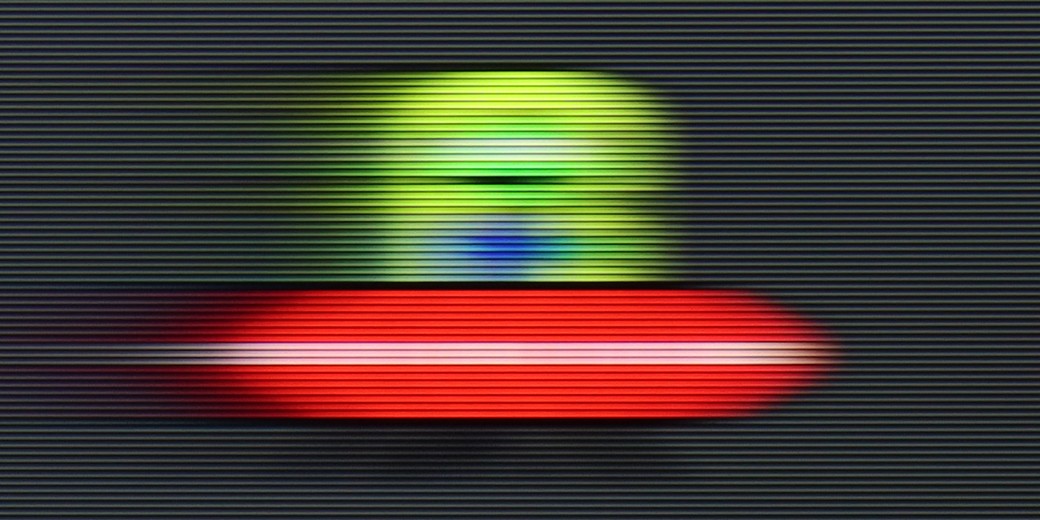
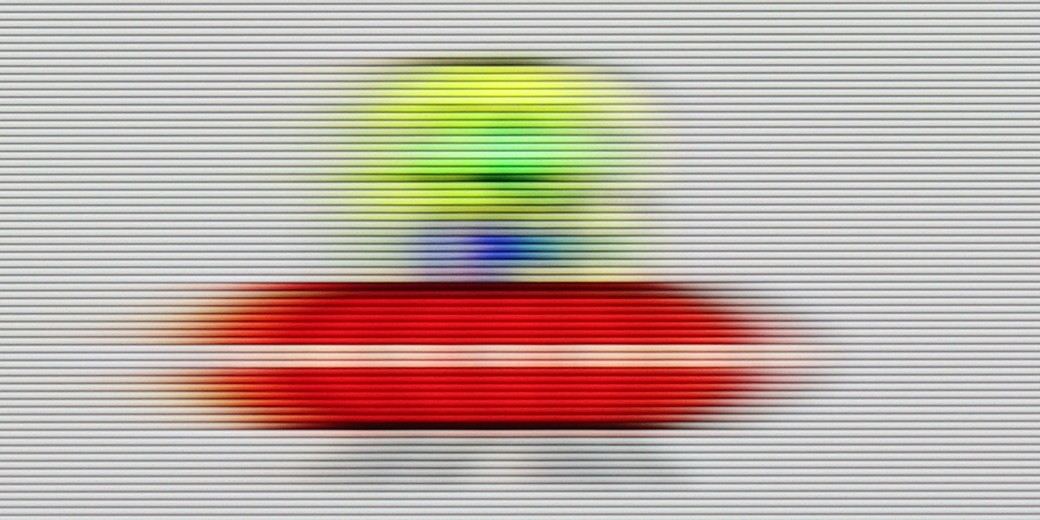
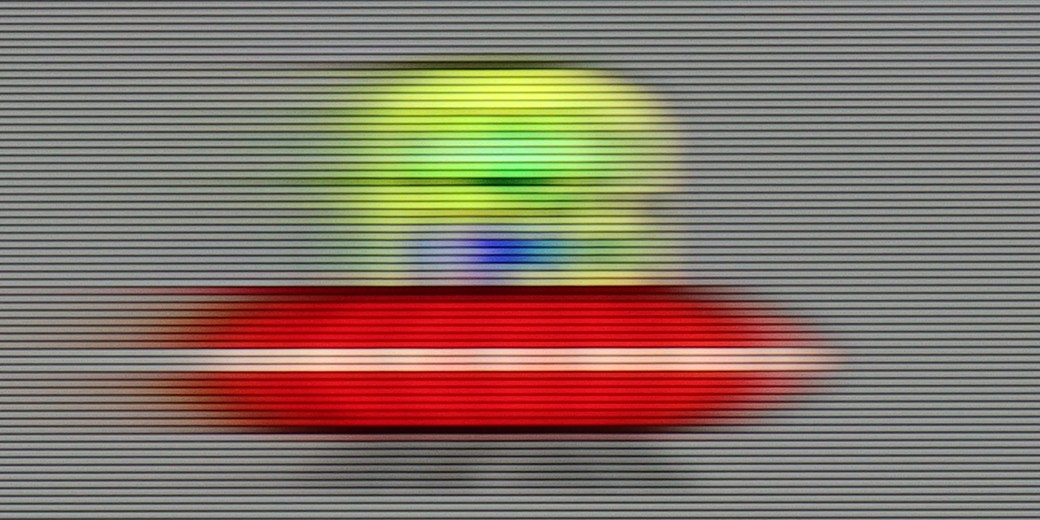
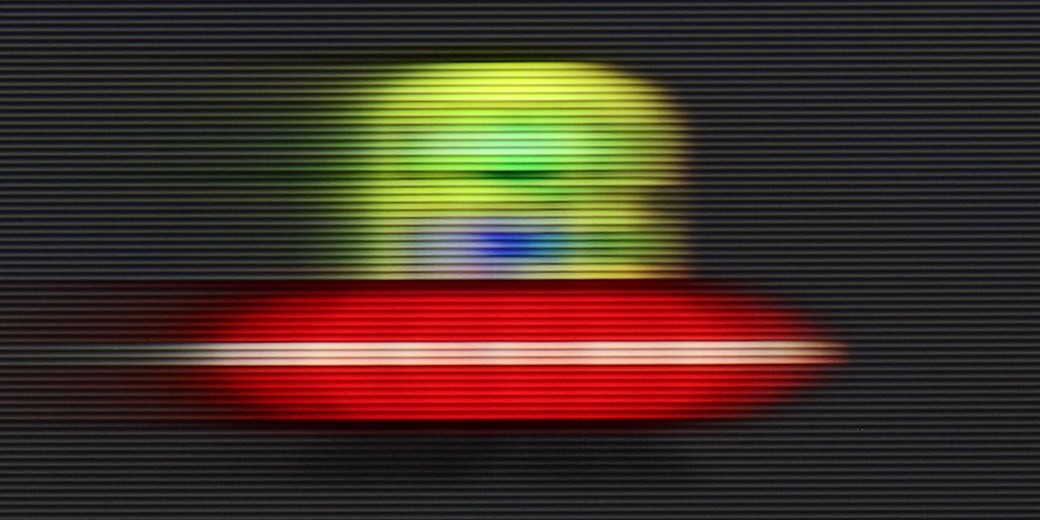
The matrix in the K85F model operates at a native refresh rate of 60 Hz, which right from the start sets certain expectations regarding image fluidity. However, we must admit that we were very positively surprised when we found two separate sliders for motion control in the settings menu: one labelled as "Motion Blur Reduction" and the other "De-Judder". Such generosity in this price segment is an absolute rarity, as typically manufacturers offer at most one shared option. Unfortunately, our enthusiasm waned as quickly as it appeared. It soon became clear why Haier was so "generous" – the slider responsible for motion blur reduction is simply a dummy. Its adjustment brings absolutely no visible effect on the screen, so only one of the two options works.
The issue of motion fluidity and blurring is largely predetermined by the use of a 60-hertz panel, which naturally makes it difficult to recommend this receiver to enthusiasts of very dynamic content. Fortunately, in the Q80FUX, we find a few options (although, as we shall see shortly, in reality only one) that are supposed to improve the experience with older film productions. There is a "De-Judder" slider available, which actually controls the smoothness of the image and allows us to adjust it to our preferences: from raw, cinematic frame rates to a more theatrical, smoothed presentation. However, a true surprise awaits us just beside it in the menu. There is also a second slider, supposedly dedicated to removing blur – a feature we typically encounter in 120Hz panels to combat motion blur in sports. However, as we expected, recalling memories from the tests of the K85F model, this slider here is merely a façade. Its adjustment does absolutely nothing to the image and it simply appears to be an oversight by the product engineers who left a non-functional option in the software for this type of panel.
Console compatibility and gaming features
4/10
5.6/10
- ALLM
- VRR
- VRR range48 - 60Hz48 - 120Hz
- Dolby Vision Game Mode
Yes, high input lag
- Correct implementation of HGIG
- 1080p@120Hz
- 1440p@120Hz
- 4K@120Hz
- Game bar

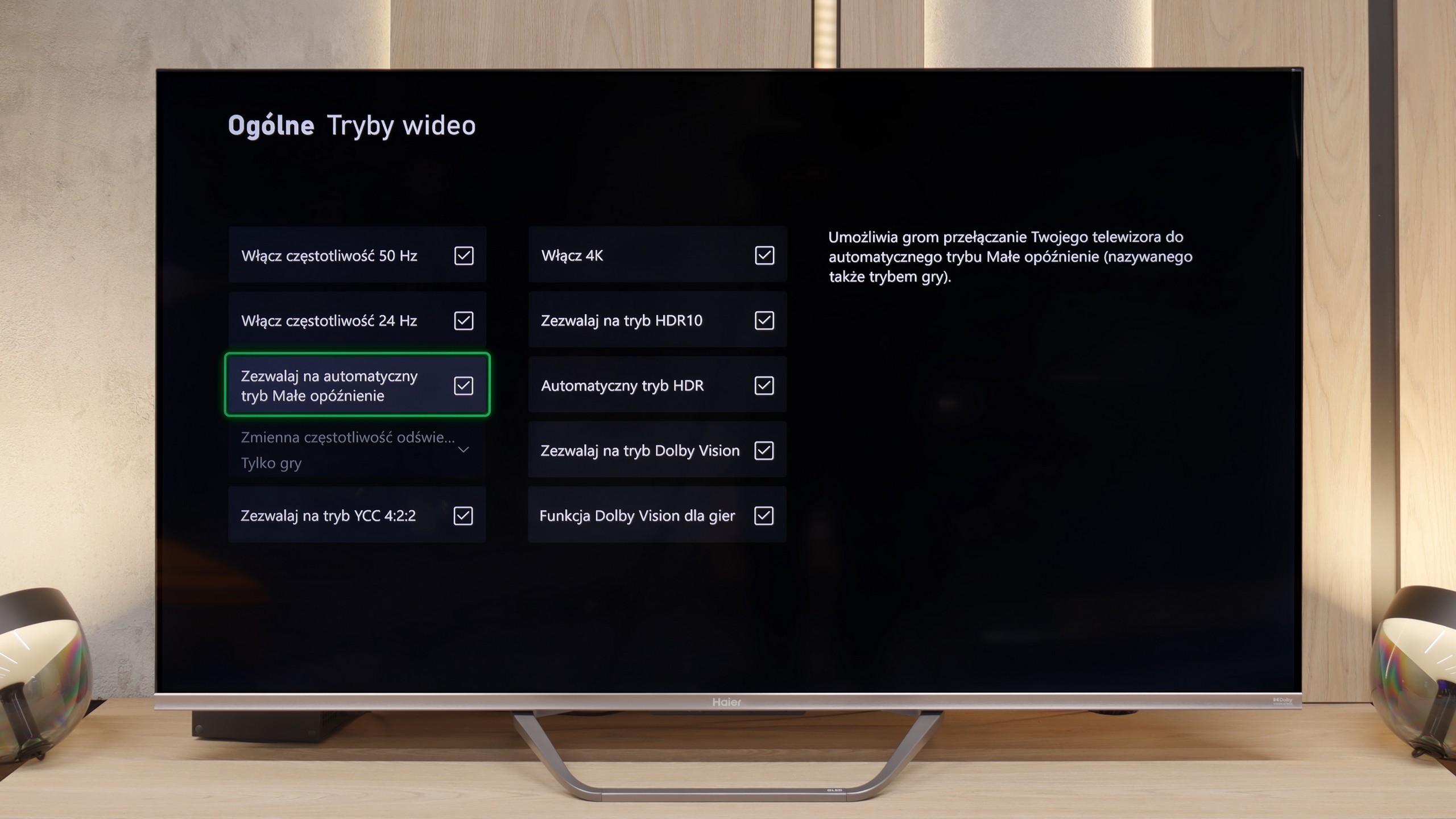
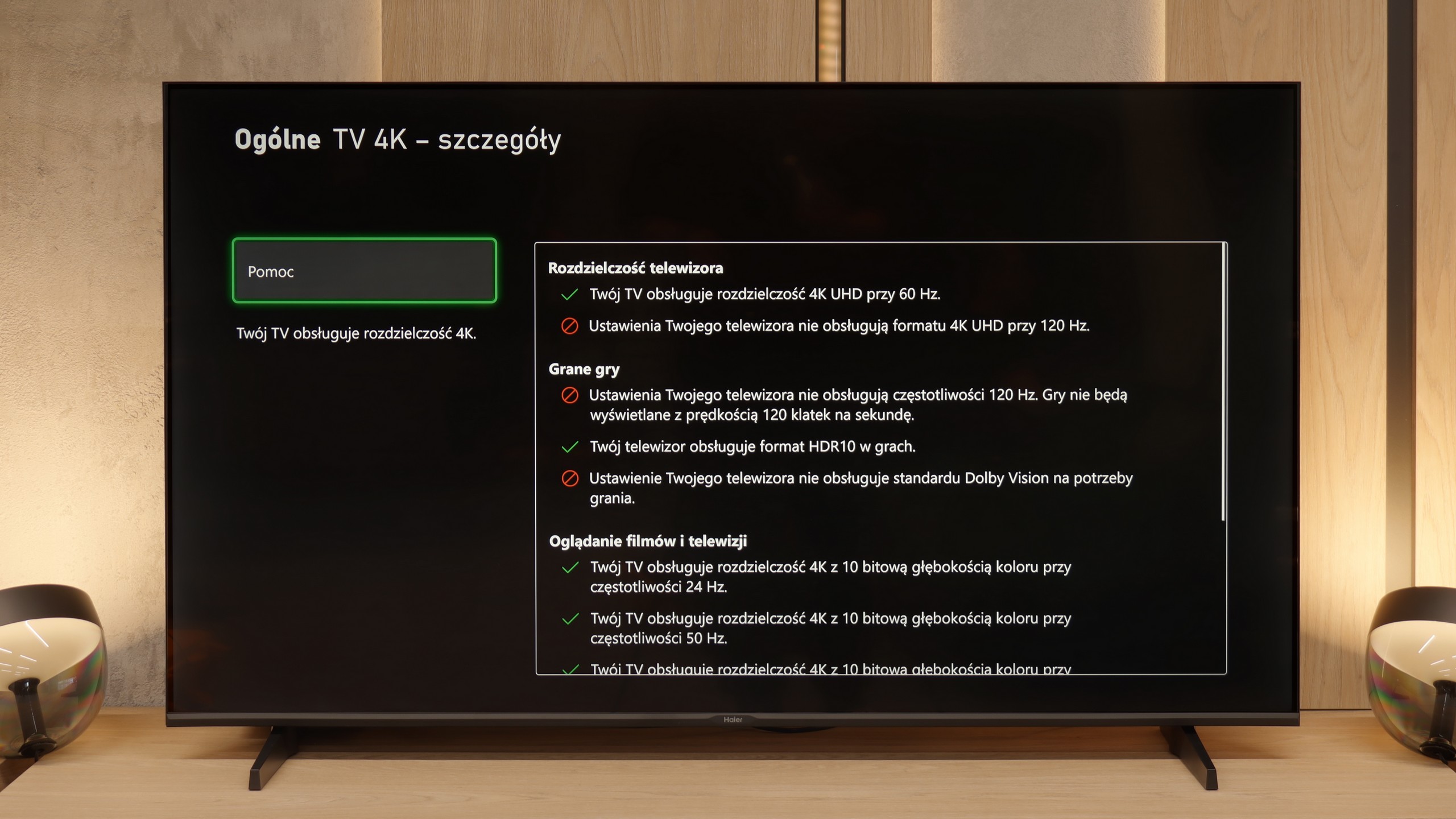
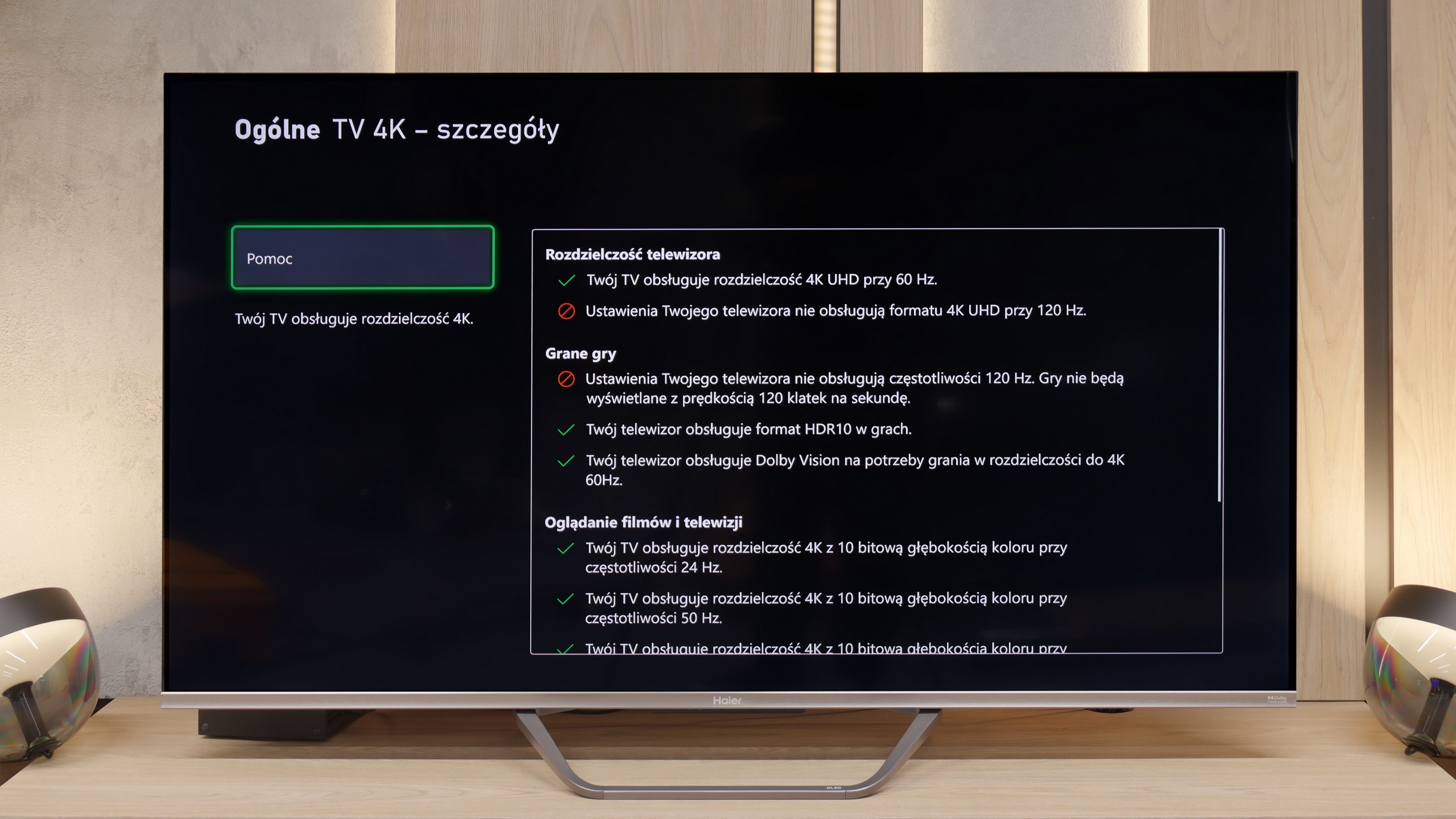
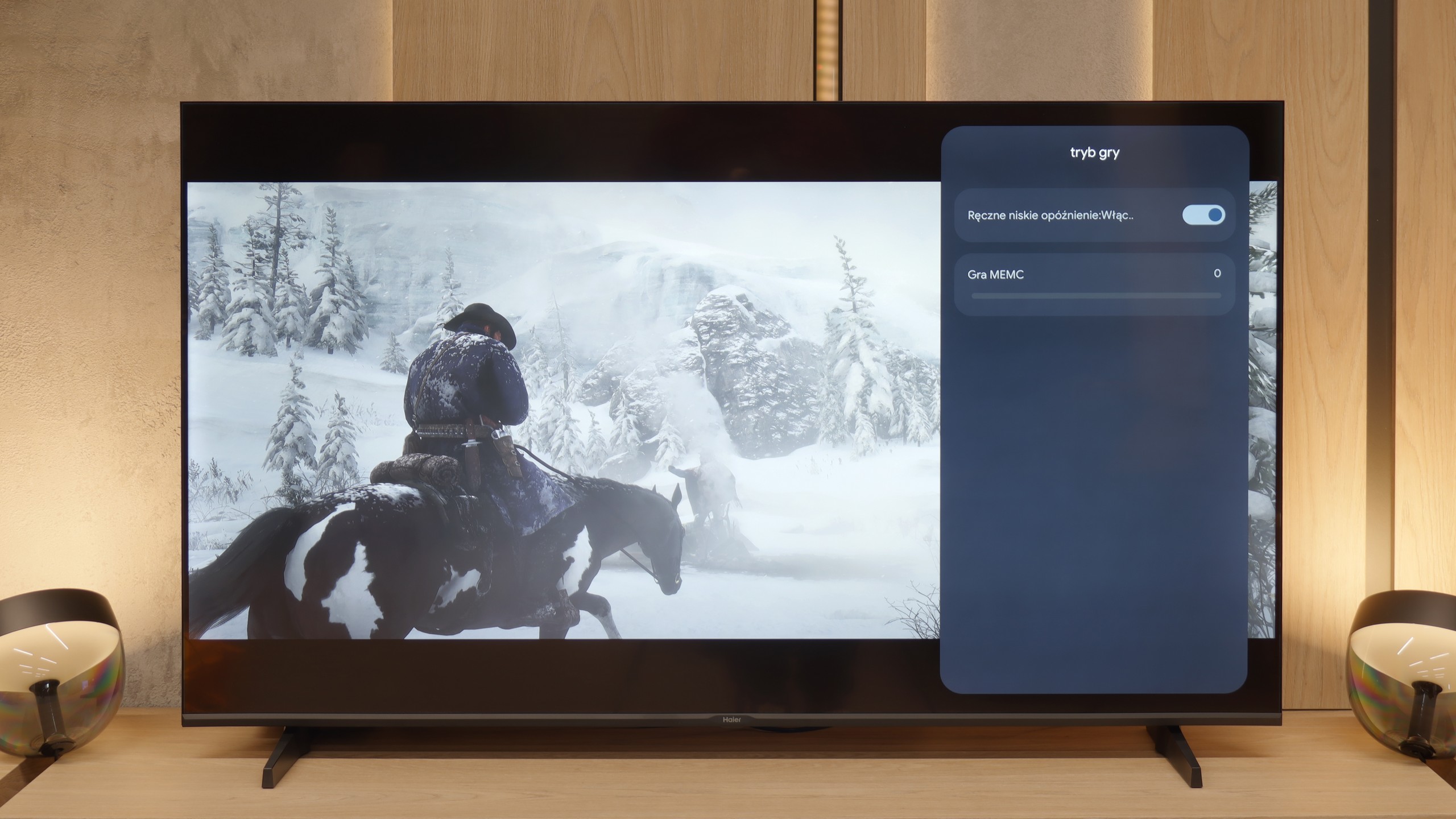



Let's move on to features for gamers, although we must emphasise at the outset that this is more of a proposal for the "casual" ones. The manufacturer boasts in the specifications about the presence of HDMI 2.1 ports, which looks impressive on paper, but in reality, it is largely a marketing ploy. What good is a modern port if the heart of the television is a panel with a refresh rate of 60 Hz? It physically cannot display a signal at 120 frames per second, even at lower resolutions, which deprives the HDMI 2.1 port of its most significant advantage. It's a shame. (That’s why we mark it as HDMI 2.0 in our tests). Another curious peculiarity is the television's reaction to attempts to calibrate HDR from the console level. Changes to brightness settings cause very unnatural image behaviour, which might suggest an incorrect implementation of the HGiG standard. To be honest, however, one shouldn't worry too much about this, because as we've mentioned numerous times, we simply do not recommend using any HDR content on this screen. However, to avoid being too negative, the Haier K85F also has two significant and unexpected advantages. The first is the presence of ALLM, or Auto Low Latency Mode, which switches the television to low latency mode as soon as it detects a connected console. The second, even bigger surprise, is support for VRR, or Variable Refresh Rate. While it works within a very modest range of 48-60 Hz, its mere presence is commendable. As a result, the image in games can experience less "tearing," which significantly improves the gaming experience.
Stepping into the realm of gaming, the Haier Q80FUX proves to be quite a decent companion for the "casual gamer". Onboard, we find highly desired features such as VRR (Variable Refresh Rate) and ALLM (Auto Low Latency Mode). However, the biggest surprise is something else altogether. Although we are not dealing with a 4K@120Hz panel here, the television is capable of accepting and displaying a 120Hz signal at a lower resolution (Full HD). This is a very useful feature that allows for a conscious switch of the console to a lower resolution mode in exchange for significantly higher smoothness, which is a compromise entirely acceptable in the gaming world.
We won’t particularly complain about the lack of extras like the "Game Bar", as it's merely a nice addition. The most concerning issues arise when we delve into the world of HDR in gaming. Due to the television constantly adapting the signal "in its own way", setting the brightness on the console according to the HGIG standard is nearly impossible to achieve as per instructions. Worse still, in the Dolby Vision mode for gaming, the input lag increases to around 50 ms, which is a value high enough to render this mode practically unusable. However, in general, we would not recommend gaming on this television in HDR mode, so these are not such grave shortcomings. What is most pleasing is the presence of 120Hz in Full HD, which makes the Q80FUX a rather nice television for the occasional gamer.
Input lag
10/10
9.4/10
SDR
HDR
Dolby Vision
We must, however, give Haier its due – there is one parameter in which this television absolutely shines and embarrasses many more expensive models. We are speaking about input lag, or signal delay. Our measurements showed an impressively low result of just 13 ms. This is a huge plus that makes gaming controls lightning-fast and incredibly responsive. In this regard, the K85F performs excellently.
If there is one category in which the Haier Q80FUX absolutely shines and shows its claws, it is input lag. In this regard, the television presents results that are nothing short of remarkable. In 120Hz mode (achieved, let us remind you, at a lower resolution), input lag drops below 10 ms, which is an excellent value, worthy of high-end gaming monitors. Not much worse, and still at a very good level, is the classic 60Hz mode – here the measurements consistently indicated around 12-14 ms. These are results that significantly more expensive, dedicated gaming designs would not be ashamed of. The only serious stumble here is the Dolby Vision mode. As we have established before, its activation raises the lag to an unacceptable level, so we definitely advise against using it during any interactive gameplay.
Compatibility with PC
6/10
6/10
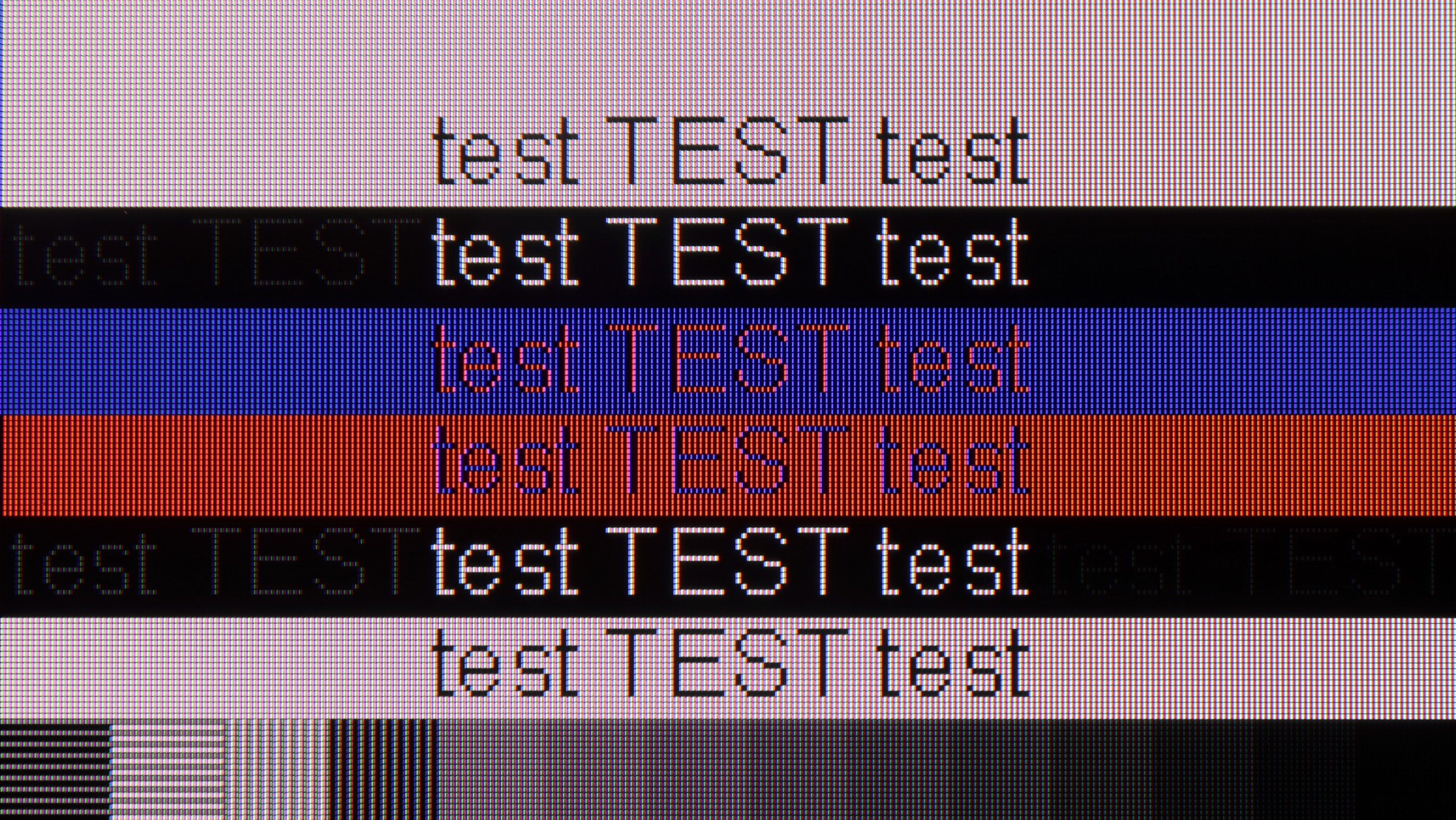

And what if you tried using this Haier as a monitor for your computer? Here, to our great surprise, the television performs remarkably well. For office work – it is ideal. This is all thanks to its proper support for what is known as chroma subsampling 4:4:4. In plain terms: every, even the smallest letter on the screen is sharp, without annoying coloured outlines or blurring. Of course, let's be straightforward – this is not equipment for PC gamers. 60 Hz is too little for them. But if you simply need a large screen for text work, browsing the internet, coding, or displaying presentations, the K85F will excel in this role. This is one of its strongest and, to be honest, most unexpected applications.
We also checked, of course, how the Q80FUX performs when connected to a computer. And here’s another pleasant surprise – it handles this really very well. The most important thing is that the fonts are very readable, so nothing blurs and you can work on it normally. Additionally, just like with consoles: we can set a lower resolution here in exchange for achieving a high refresh rate of 120Hz. Importantly, in this mode, G-Sync launched correctly and worked well. This only confirms that this television is truly a successful and efficient piece of equipment for gaming, even on a PC.
Viewing angles
2.8/10
3.3/10
At almost the very end of the assessment of the panel itself, we left the viewing angles, which unfortunately are one of its biggest weaknesses. However, it must be honestly admitted that this is no surprise – it is simply a natural and commonly known characteristic of VA-type panels. In the specimen we tested, interestingly, the brightness of the image did not drop dramatically when we moved away from the centre of the screen. The real problem, however, lies in the colours, which start to fade instantly. A slight change in position on the sofa is enough for the colours to lose their saturation and become washed out. In this respect, the Haier K85F presents a rather mediocre level, typical for this technology.
Anyone who plans screenings in a wide family group must be aware of the fundamental compromise that Haier has made by implementing a VA panel in this model. This technology has indeed given us deep blacks and high contrast, but its inherent characteristic is also a noticeable narrowing of viewing angles. It is enough to sit a bit further to the side of the sofa to immediately notice how the colours start to lose saturation and the image begins to fade. It’s simply a classic trade-off – we gain something (contrast) at the expense of something else (angles) – and the Q80FUX fits perfectly into this pattern.
TV efficiency during daytime
4.1/10
4.8/10
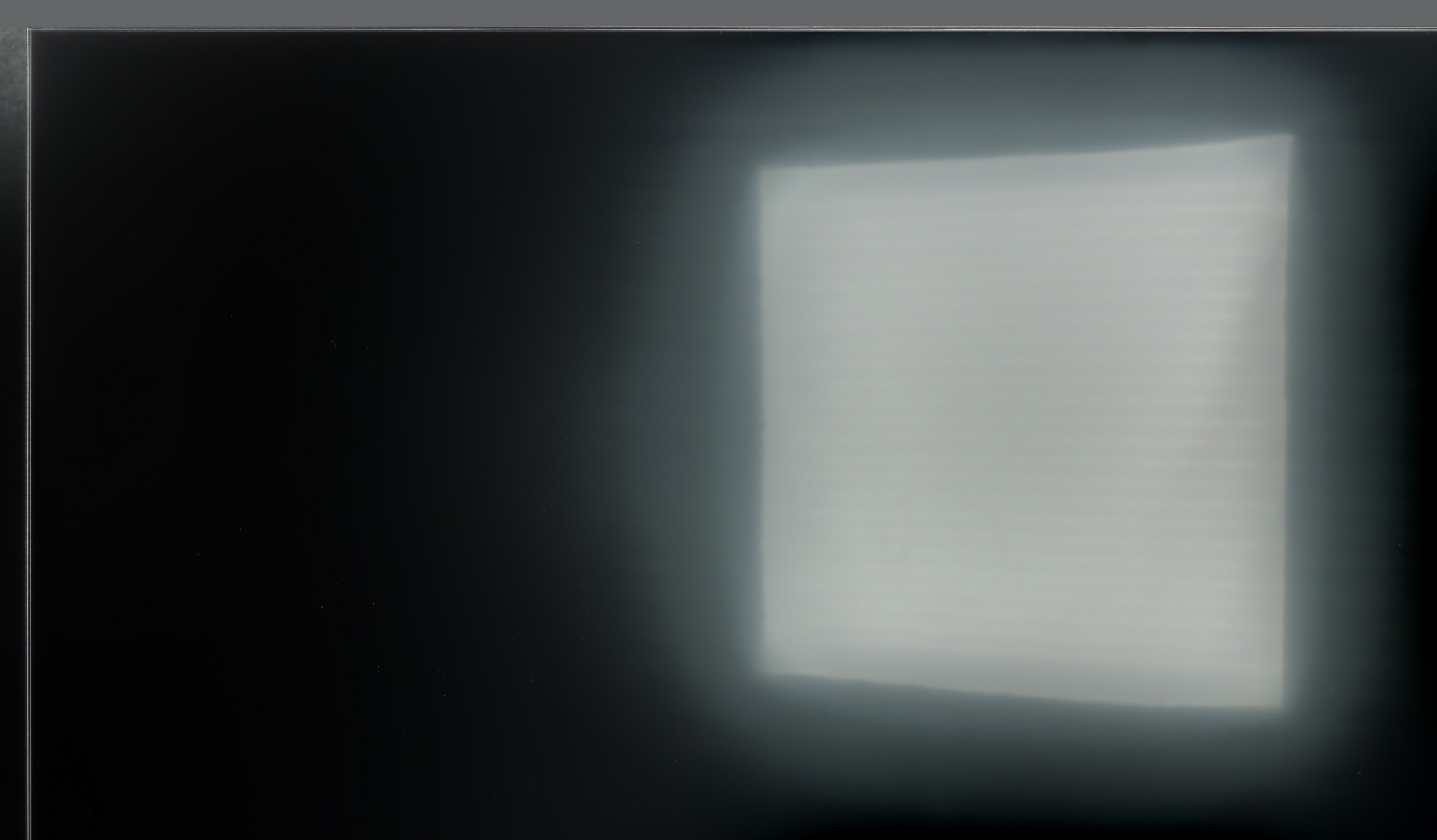
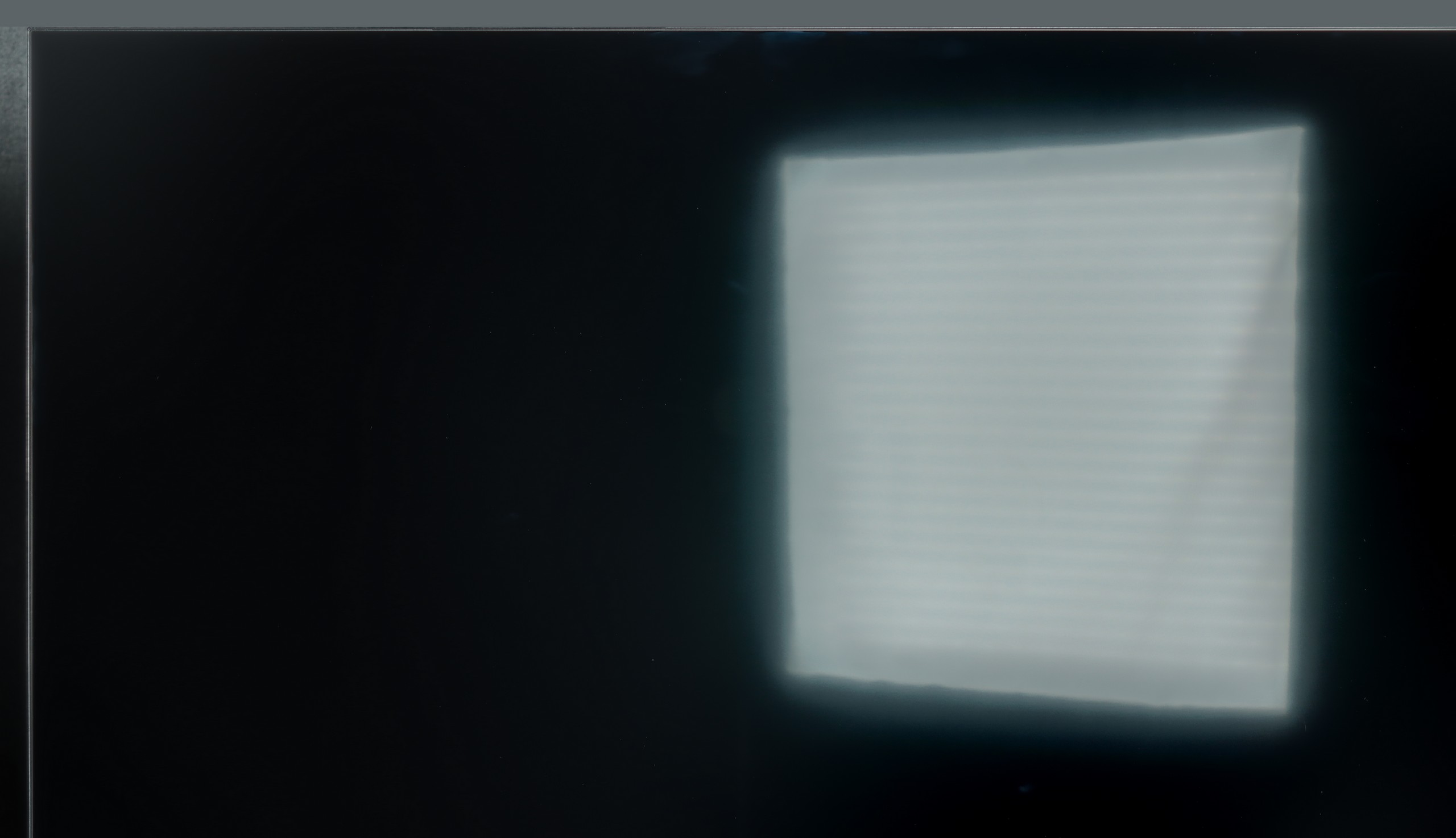


Matrix brightness
Average luminance SDR
Haier Q80FUX: 317 cd/m2
Haier K85F: 276 cd/m2
And how does the television perform in confrontation with daylight, for example in a brightly sunlit living room? Unfortunately, we do not have good news here. As we have already established, it is a television with relatively low brightness, which becomes a serious drawback when faced with sunlight. The situation is further worsened by the screen coating used. Instead of effectively suppressing reflections, its satin structure tends to unfavourably scatter them. In practice, this means that the reflection of a window or lamp turns into a large, blurred, milky halo, which degrades contrast and effectively hinders viewing. The conclusion is therefore clear: if the television is to be placed in a bright room, the K85F model will not be a good choice.
The clash of the receiver with the daily challenges posed by a bright living room is quite decent in the case of the Q80FUX, although it is certainly difficult to speak of it as ideal. The panel itself is equipped with a coating that handles most reflections and glare from the surroundings quite effectively. Equally importantly, even in more challenging lighting conditions, the screen manages to retain pleasantly saturated colours. However, the weakness of this construction reveals itself where the brightness comes into play. The previously mentioned, rather moderate maximum brightness (around 350 nits) means that in confrontation with intense, natural light coming through the window, the screen often struggles to "break through". On a sunny day, the image may simply lack the appropriate impact.
Details about the matrix
Subpixel Structure:
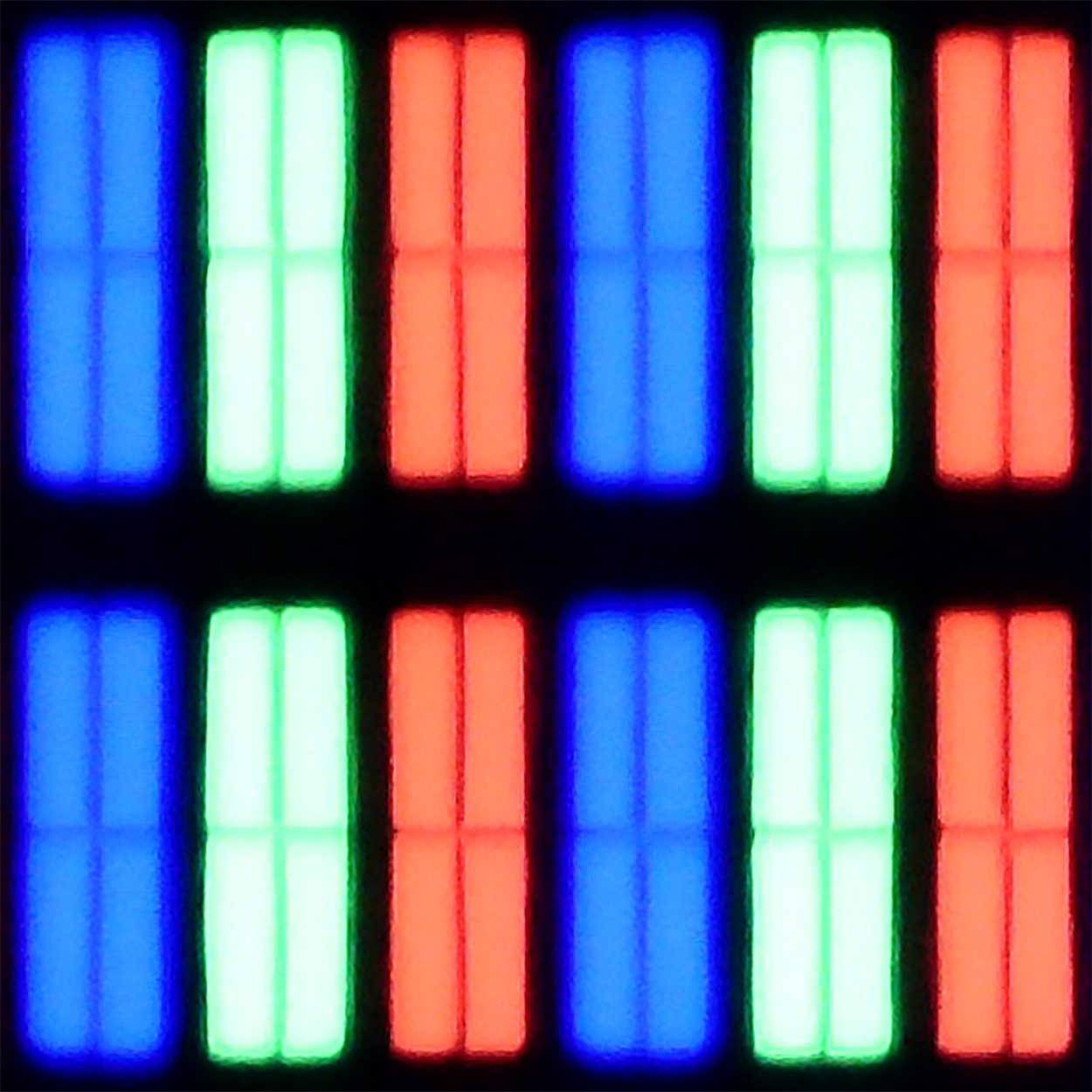
Panel uniformity and thermal imaging:
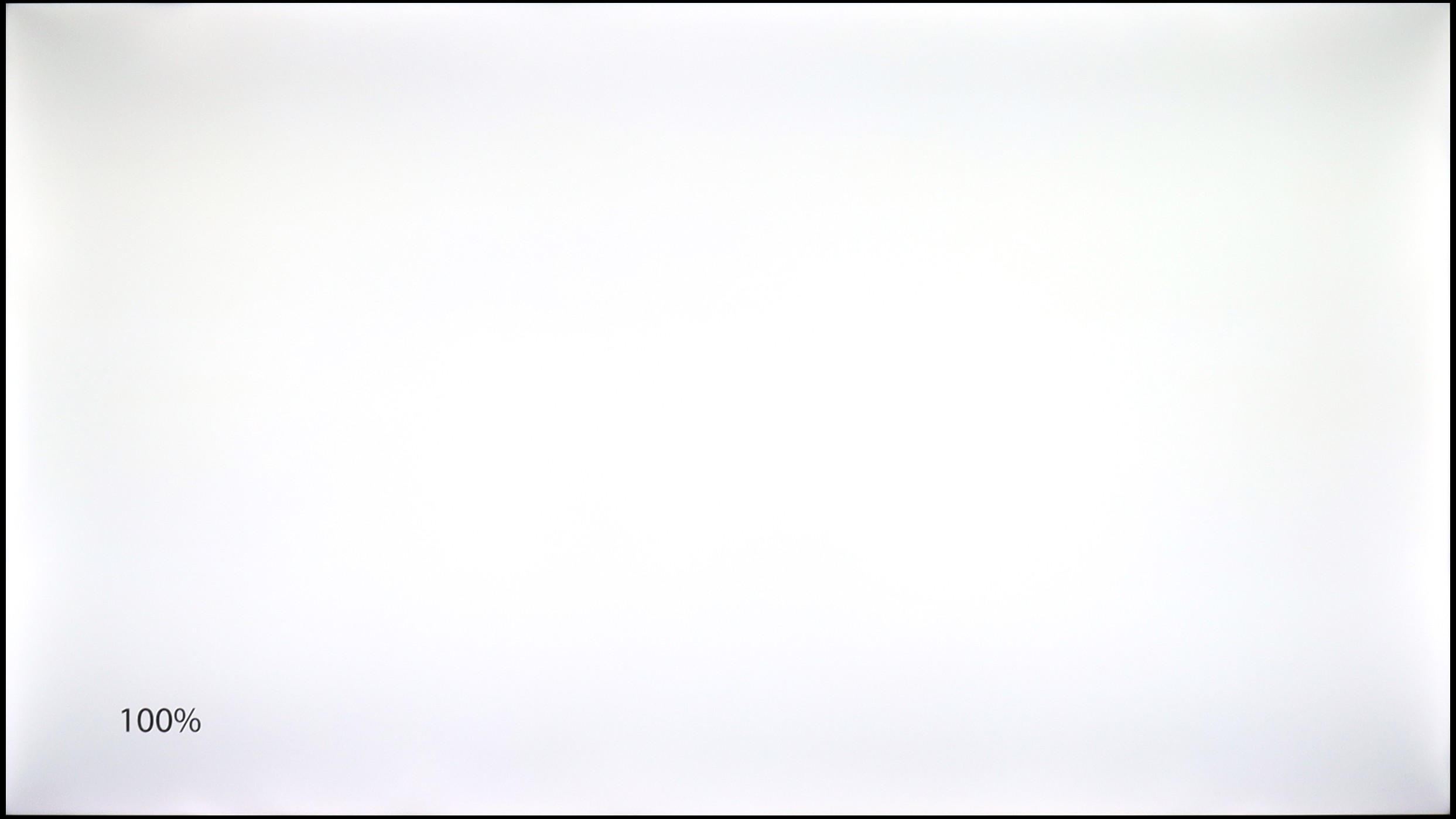
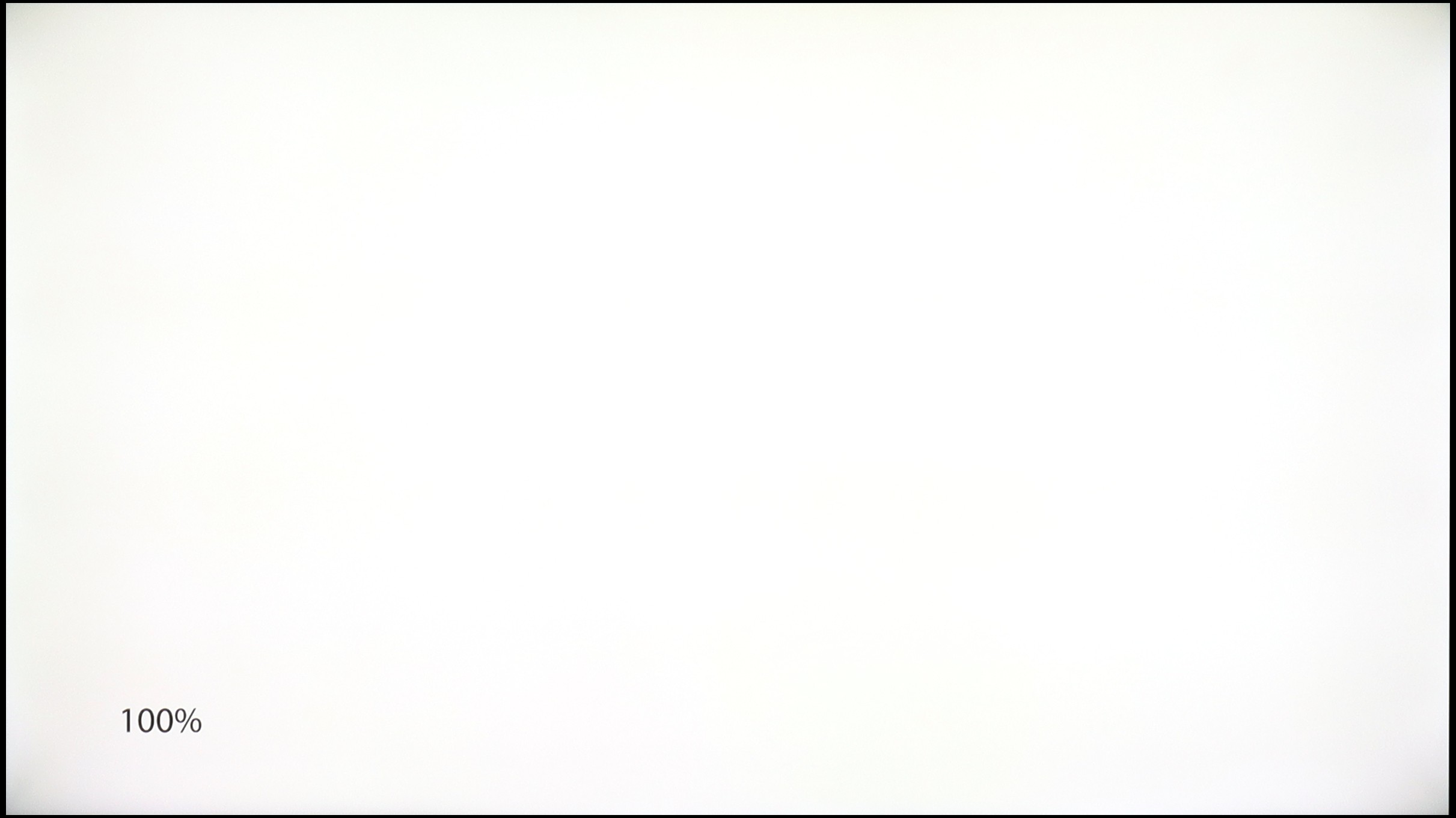
Haier K85F
Haier Q80FUX
TV features
5.5/10
5.6/10
- HDMI inputs4 x HDMI 2.0, 0 x HDMI 2.14 x HDMI 2.0, 0 x HDMI 2.1
- Other inputsRCA (Chinch)RCA (Chinch)
- OutputsToslink (Optical audio), eARC (HDMI), ARC (HDMI), Mini-Jack (Headphones)Toslink (Optical audio), eARC (HDMI), ARC (HDMI), Mini-Jack (Headphones)
- Network InterfacesWi-Fi 2.4GHz, Wi-Fi 5GHz, Ethernet (LAN) 100MbpsWi-Fi 2.4GHz, Wi-Fi 5GHz, Ethernet (LAN) 100Mbps
- TV receptionDVB-T, DVB-T2, DVB-S, DVB-S2, DVB-CDVB-T, DVB-T2, DVB-S, DVB-S2, DVB-C
Classic features:
- Recording to USB (terrestrial TV)
- Recording programming
- Picture in Picture (PiP)
- RF remote control (no need to aim at the screen)
- Backlit remote control
- Teletext
- Audio only mode
- Bluetooth headphones support
- Simultaneous Bluetooth headphones & TV audio
Smart features:
- AirPlay
- Screen mirroring (Windows Miracast)
- Voice search
- Voice search in native language
- Ability to connect a keyboard and mouse
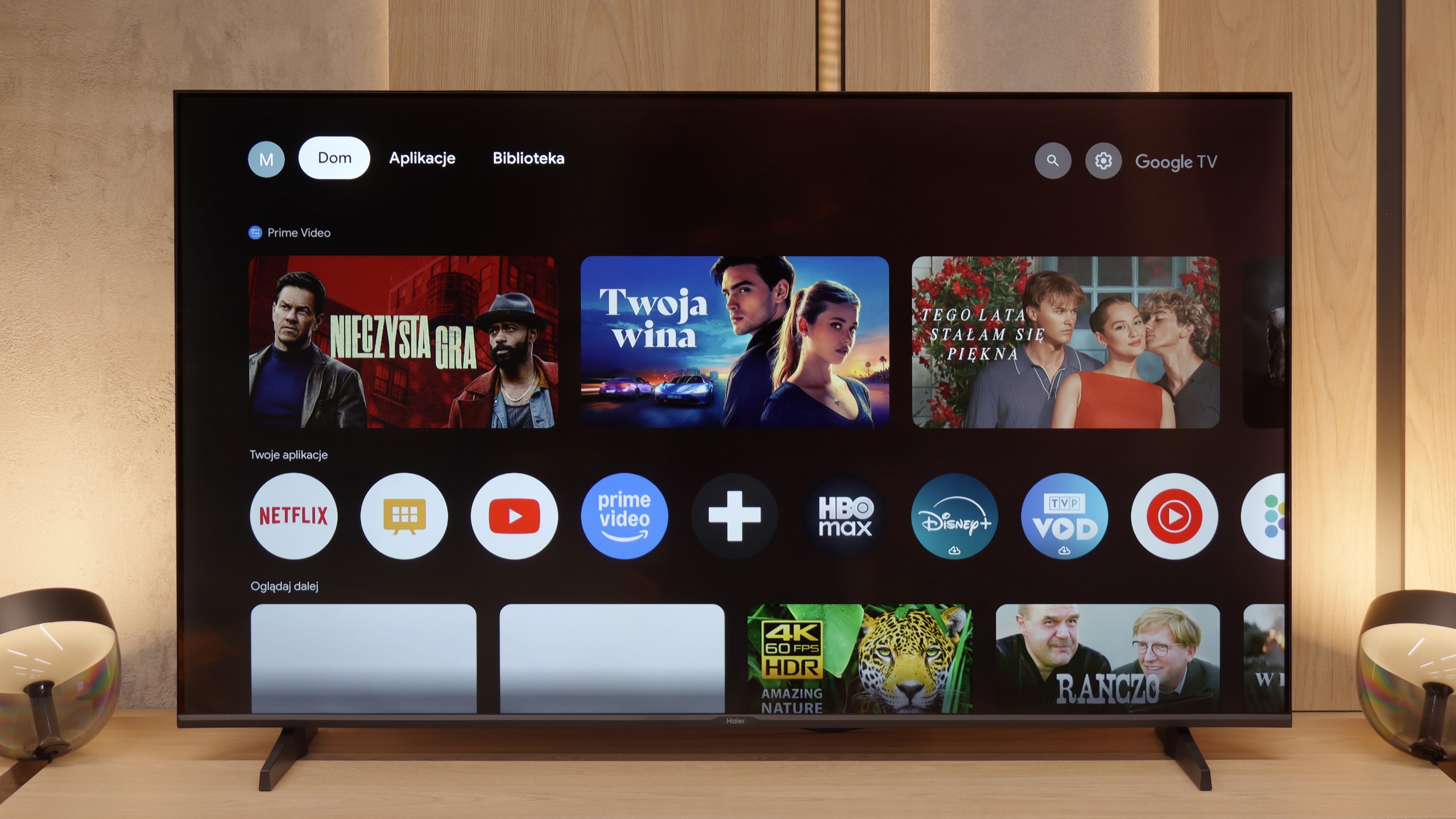

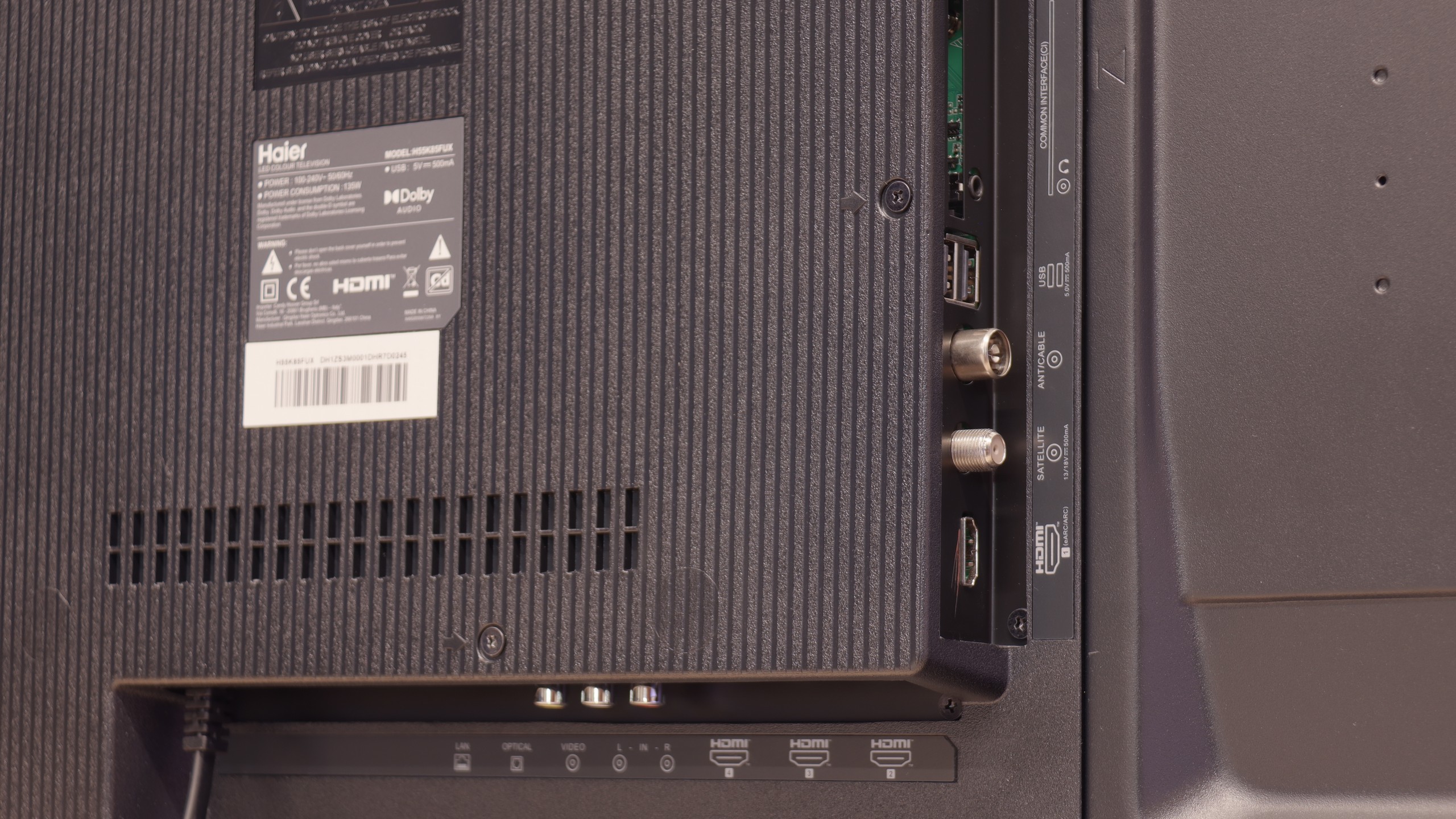
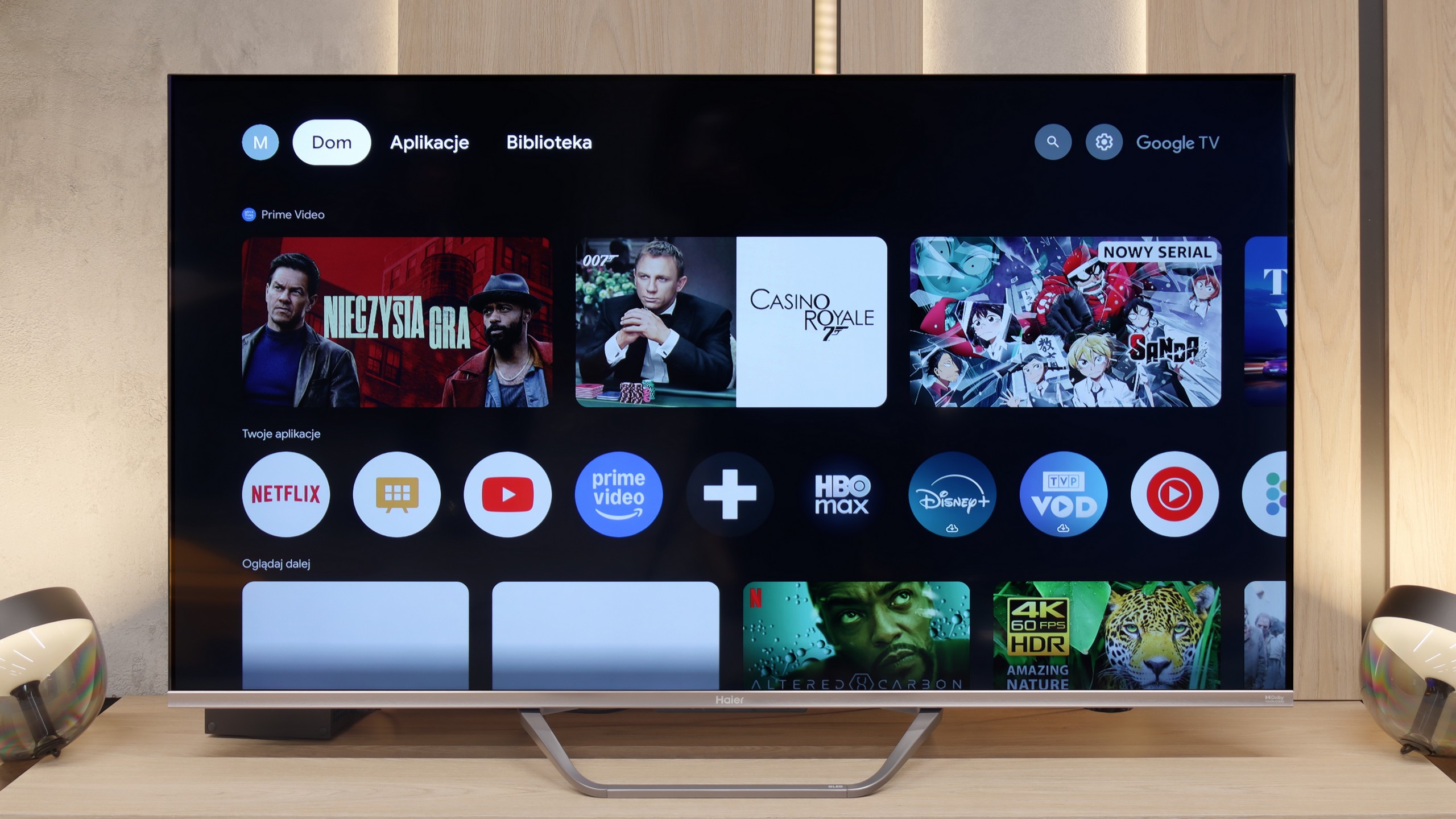


GoogleTV on Haier K85F
The heart of the television is the Google TV system, which in theory should be its huge advantage. Access to thousands of applications and a wealth of features are promises we are familiar with. Unfortunately, in Haier's execution, it is one of the worst implementations of this software we have encountered. The system runs painfully slowly, and the interface is notoriously unresponsive. However, the real nightmare is the incorrect and often downright comical translations of some menu options, making it difficult at times to understand what is even being referred to. To make matters worse, during our testing, we were unable to activate the AirPlay function, which simply did not work.
Classic features on Haier K85F
Let's move on to the classic features and connections, as this is where the story gets even more interesting. The rich array of ports is definitely a plus, including four HDMI ports and a rarely seen mini-jack headphone output. Unfortunately, the television does not offer either USB recording or PiP mode. However, the real ordeal begins with the remote control. Our first attempts to pair it via Bluetooth to activate radio frequency (RF) control and voice functions ended in total failure. After dozens of attempts, we were sure it was just a manufacturing defect. And here's the surprise: after a long struggle, we discovered that the remote could be paired, but it had to be done from the native Google TV settings, completely bypassing the non-functioning Haier overlay. This is a perfect example of how terrible software can ruin basic functionality. Oh, and one more thing. In the box... there weren't even any batteries for the remote.
SmartTV on Haier Q80FUX: GoogleTV
Let's start with the smart layer, which in the Q80FUX is managed by the Google TV system. This is theoretically a huge advantage, opening access to an incredible library of apps, facilitating screen mirroring from mobile devices, and offering convenient voice search. Unfortunately, just like in other models from this brand that we tested, the implementation of this platform leaves much to be desired. It's not even about drastic stuttering or delays in navigation, but rather a festival of minor errors, oversights, and terrible translations in the menu. Because of this, it's hard to regard "Google TV" in Haier's version as equal to what we find in receivers from Sony or TCL, even though the same proudly sounding name is displayed on the box.
Classic Features
Moving on to the classic, functional features of the television, the image of the device does not improve at all. The only commendable aspect is the presence of Bluetooth connectivity and an unusual but useful relic from the past in the form of an analogue headphone jack output. Aside from that, it's hard to find anything that would excite us. Due to the problematic software, the receiver (like its predecessors in our tests) was unable to find any terrestrial television channels, despite other televisions connected to the same installation having no issues whatsoever. The remote control itself is also strange – its design may appeal to some, but due to the lack of a numeric keypad and the absurd placement of some buttons on the side edge, it definitely cannot be called senior-friendly.
Playing files from USB
9.4/10
9.6/10
Supported photo formats:
Maximum photo resolution:

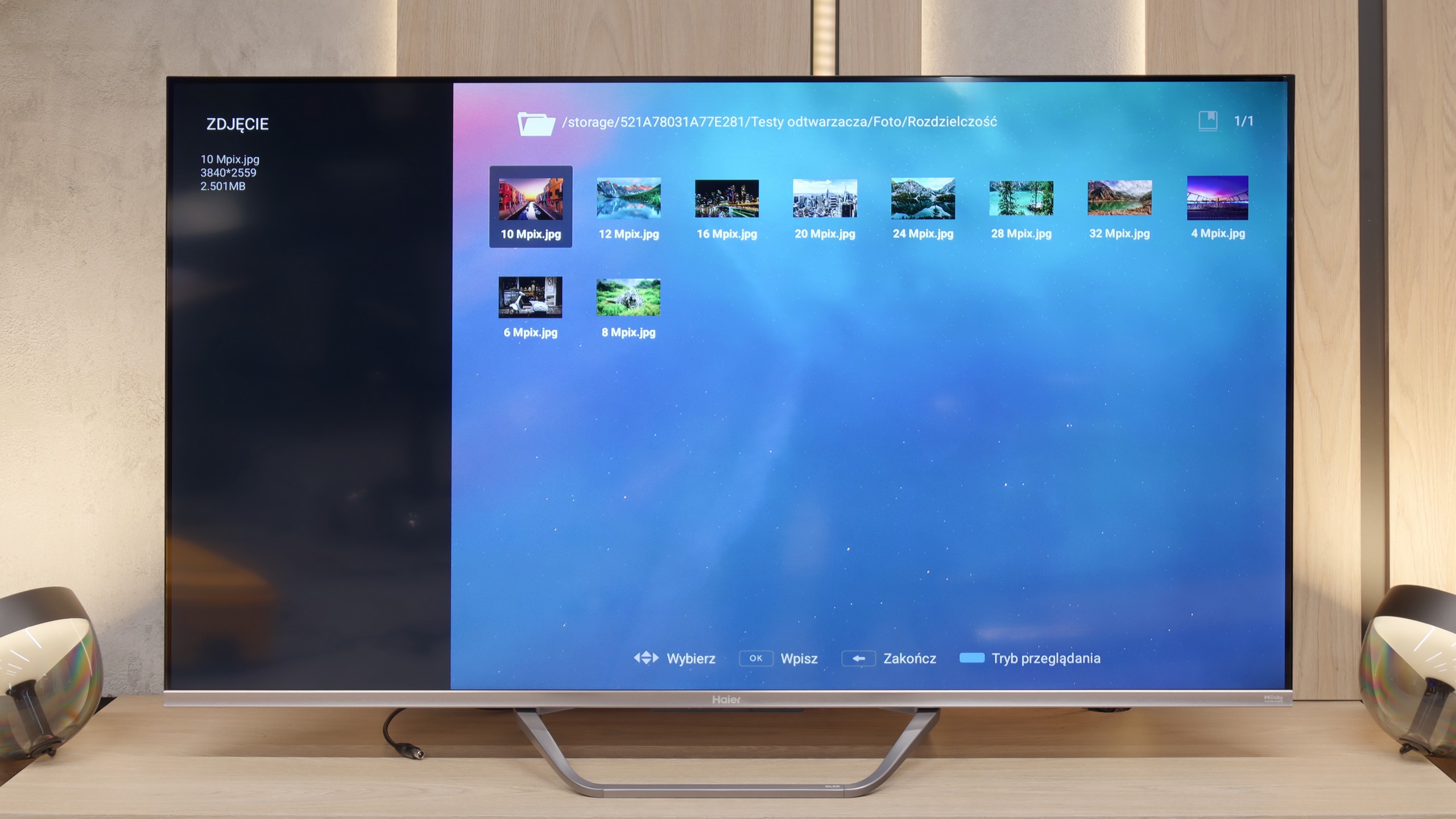
After all our complaints about the unfinished software, the moment came when we experienced absolute shock. It turns out that in this buggy and slow-operating system there is a function hidden that works almost perfectly and puts industry veterans to shame. We are talking about the built-in media player for files from USB drives. It is a true multimedia powerhouse that played virtually every video format we threw at it – from the most popular to the completely niche. Haier, a newcomer in the TV market, has achieved something that many manufacturers with decades of experience have struggled with for years. Who knows, perhaps it was originally intended to be a reliable player for conference rooms? Regardless of its origin, the result is excellent!
We must admit that after a series of setbacks we experienced in assessing the overall implementation of the Google TV system, we approached the media player test with considerable reservation. Meanwhile, in this one specific aspect, the Q80FUX served us a genuine surprise. The built-in application for managing files from USB drives works simply excellently. This software component seems to be completely immune to the ailments that afflict the rest of the system, opening practically all the most important and popular video file formats that we presented to it.
Apps
9.6/10
9.6/10














































Sound
4.8/10
5.5/10
- Maximum volume83dB84dB
- Dolby Digital Plus 7.1
- Dolby True HD 7.1
- Dolby Atmos in Dolby Digital Plus (JOC)
- Dolby Atmos in Dolby True HD
- DTS:X in DTS-HD MA
- DTS-HD Master Audio
When it comes to sound, the review will unfortunately be very brief. The biggest advantage of the built-in speakers of the K85F is really just that they are there and produce sound. Other than that, the sound is completely flat, devoid of any bass, and simply anemic. Yes, on the TV's box, we will find the Dolby Atmos logo, but when faced with the physical capabilities of these drivers, it is a feature that exists only on paper. The verdict can, therefore, only be one: when planning to purchase this television, you should immediately add a soundbar to your budget.
When it comes to acoustic "experiences", the Haier Q80FUX seems to adhere to the principle that sound is simply meant to be there. And it is – that's about all that can be said. The built-in speakers deliver an exceptionally flat sound, lacking character, and above all, they lack any distinct bass foundation. A small consolation is the fact that the television supports Dolby Atmos format. However, let's be honest: to truly benefit from the merits of this codec and hear the promised spatial quality, passive decoding capability is not enough. Connecting an external home theatre system or at least a decent soundbar is, in this case, not just a recommendation but an absolute necessity.
Sound Quality Test
Acoustic Measurements
83dBC (Max)
75dBC
84dBC (Max)
75dBC
